During the 19th and early 20th centuries, Shanghai was famous as China’s international city, a busy trade port with notorious underworld . During the latter part of the 20th century, the city languished through Mao’s Great Leap Forward and Cultural Revolution, before once again becoming a world-class city leading in finance, technology, and culture at the turn of the millennium.
There was a very brief time after WWII, only four years, when the city was under the Kuomintang (KMT), or nationalist Chinese government. What makes this period interesting militarily, was the unusual combinations of WWII weaponry fielded there, and a now largely-forgotten American military presence in China.
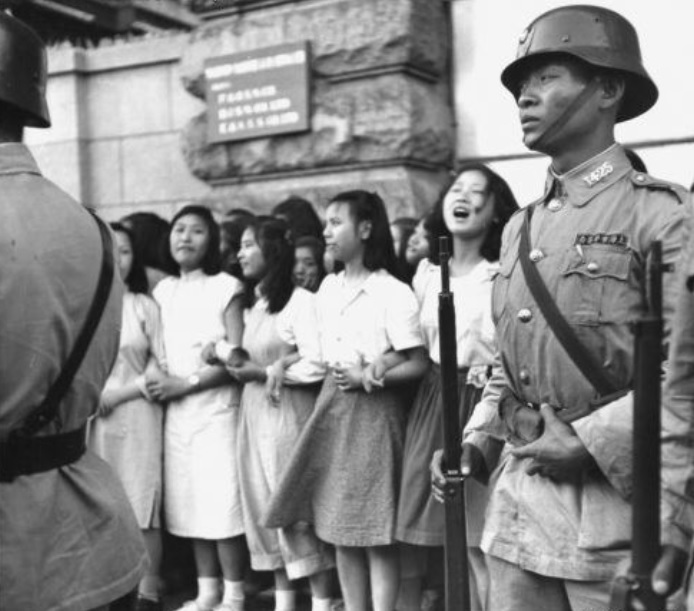
(Officers of the Shanghai Police Department monitor a political protest in 1948. Equipment includes a stahlhelm M35 helmet and Arisaka Type 38 rifle.)

(An abandoned Mitsubishi Ki-21 “Sally” bomber sits opposite American C-46 Commando, C-54 Skymaster, and C-47 Skytrain transports at a former Japanese airbase near Shanghai after WWII.)

(Soviet-made T-26 and American-made M3/M5 Stuart tanks of the nationalist army together in Shanghai during 1949. An irony of this last battle is that the nationalists were partially equipped with Soviet gear and the communists were partially equipped with American gear.)
Shanghai before & during WWII
As a legacy of the “unequal treaties” foisted upon the Qing Dynasty, pre-WWII Shanghai was an odd creation. Most of the city was Chinese-controlled. However the northern part of the Bund (the main commercial and banking district; what most people think of “classical” Shanghai) along with a stretch of the Huangpu River’s north bank was the International Settlement. In theory still a part of China, the International Settlement was de facto run by a council of Britons and Americans governing the Settlement’s British, American, Danish, Japanese, Dutch, Swedish, Italian, Australian, and German citizens and their business interests along with the so-called “White Russians” (people who fled the USSR after the overthrow of the czar, and their descendants), and a Jewish community of various backgrounds. Finally, the southern stretch of the Bund was the French Concession, run by and for France. The International Settlement had its own police department, courts, and schools and was in effect neither part of China yet not legally part of anyplace else. The French Concession was similar.
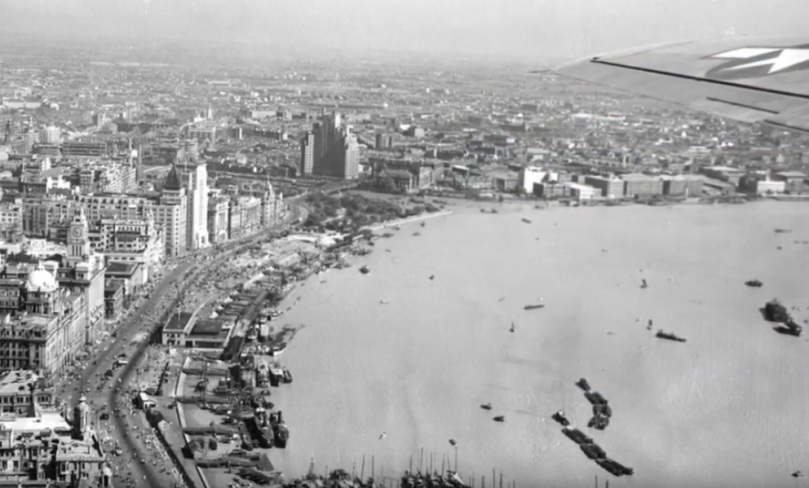
(The Bund and Huangpu river as seen from an American warplane after WWII ended.)

(A TBM Avenger torpedo plane of the US Navy overflies Shanghai’s Broadway building and Garden Bridge after the end of WWII. Built in 1934, the apartment building marks the unofficial northern end of the Bund. It was used by the Imperial Japanese Army during WWII and then briefly the American military after the war. As of 2019 it is a hotel.)
In 1937, a three-month operation by Japan captured the Chinese part of Shanghai and a portion of the International Settlement. The battle was unusual in that, as it raged in the surrounding countryside and then in the Chinese part of the city itself, both sides – but especially Japan – took pains to not hit the foreign concession areas. The remainder of the International Settlement was occupied on 8 December 1941, concurrent with the Pearl Harbor attack on the other side of the International Date Line.

(Special Landing Troops of the Imperial Japanese Navy fighting in Shanghai in 1937. Japan made use of Agent CS (concentrated tear gas) and reportedly, Agent HD (mustard gas) in parts of the city not upwind of the International Settlement.)
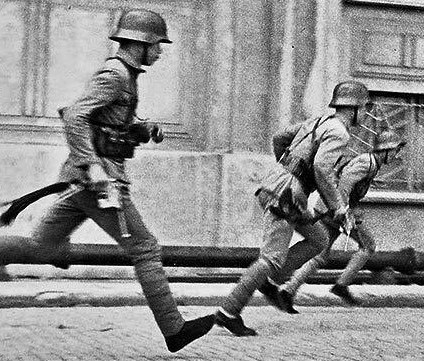
(Soldiers of the Chinese army in Shanghai during 1937. Equipment includes M35 stahlhelms and broomhandle Mausers.)
In 1935, China ordered 220,000 stahlhelms from Germany. They were manufactured by Eisenhüttenwerk AG and were of equal quality to the Wehrmacht’s. After 1937, sporadic batches of unlicensed M35 copies were also made in China, usually to lower quality. These Chinese copies were often made speculatively by private metal companies in the hopes that the Chinese army would need a fast batch after a battle against the Japanese.
The M35 stahlhelm was, at least officially, the standard helmet of China during WWII although in practice it was worn alongside captured M30-32 Tetsu-bos plus Mk.I Tommys and M1 pots Lend-Leased by the Allies.
After WWII the stahlhelm continued in declining usage by the nationalists in the Chinese Civil War. The battle for Shanghai in 1949 was its last major use. Some were taken to Taiwan by the fleeing nationalists but it was not a major piece of equipment and was soon gone. Surprisingly the communists on the mainland used some into the Korean War era.
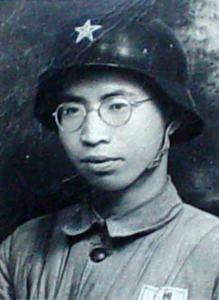
(PLA soldier with the communist red star painted on a stahlhelm in the 1950s.)
The broomhandle Mauser is an icon of Chinese firearms culture, much like the Colt Peacemaker or M1911 in the United States. Imports of this 7.63x25mm gun, initially World War One-leftover c/96 models, began from Germany in 1919 and ran to 1936, with basic c/96s, then bolo broomhandles, and commercial models all coming – 300,000 in total. China also manufactured broomhandles. Hanyang Arsenal made 16,000 c/96 clones before WWII, and Taku Naval Arsenal made 4,500. Shanxxi Arsenal made the Model 17, a broomhandle chambered for .45ACP, between 3,000 – 4,000 in total. Other arsenals made smaller numbers. Meanwhile there were copies nicknamed “Wauzers” by collectors, completely unlicensed knockoffs, made by mom & pop-type gunsmiths in numbers from a dozen to a few hundred. Some of these went to the nationalist army, and others to police departments, private warlord armies, or for civilian ownership.

(photo via Forgotten Weapons website)
Although production in China had largely subsided by the 1940s, broomhandles continued in service during WWII and afterwards in the Chinese civil war. On the nationalist side, they often served as police weapons (including Shanghai) or officer sidearms, while the communist side continued to use them as battlefield weapons.
In the communist People’s Liberation Army during the civil war and then afterwards, broomhandle Mausers were called Hé zi pào, or “box gun”, on account of the weapon being holstered inside its own hollow wood carbine stock. These remained in PLA use into the Korean War era and some ended their days being forwarded on to the Viet Cong during the Vietnam War.

(Communist soldiers with broomhandles in the late 1940s.)
the end of WWII in Shanghai
In 1945, five Imperial Japanese Army divisions in central China attempted a broad attack, in a bid to relieve pressure on both the southern Chinese front and the Yangtze river region. This operation ended up being the final Japanese offensive ever, and was unsuccessful. The Chinese army followed with a counteroffensive called the Second Guanxi Campaign in southern China, which was scheduled to conclude in September 1945, after which it was planned to pivot forces northwards along the coast and, hopefully, liberate Shanghai by the end of 1945 (WWII being widely expected to last into 1946).
On 9 August 1945, the second American a-bomb was dropped on Nagasaki, and at the same time the Soviet Union opened hostilities against Japan with a massive attack in Manchuria.
At noon on 15 August 1945, Emperor Hirohito broadcast Japan’s intent to surrender. On this day the war was still relatively far away from Shanghai. The frontlines were still 140 – 375 miles away from the city. Shanghai still had significant Japanese forces intact when WWII ended.
The main force was the 60th Infantry Division. This Imperial Japanese Army division was one of several created to garrison occupied China. As such, it was lesser in capability than divisions fighting the Pacific war, with two brigades (one of which was stripped off to replace IJA losses elsewhere) plus artillery, horse cavalry, and transport subunits. The whole 60th was not in Shanghai, with some subunits being as far as 48 miles away to guard approaches to the city.
In February 1945, the IJA 61st Infantry Division relocated from Nanking to Shanghai. Another division created specifically to garrison occupied areas, the 61st was even weaker than the 60th by late 1945, completely lacking heavy artillery and having only two understrength light infantry regiments.
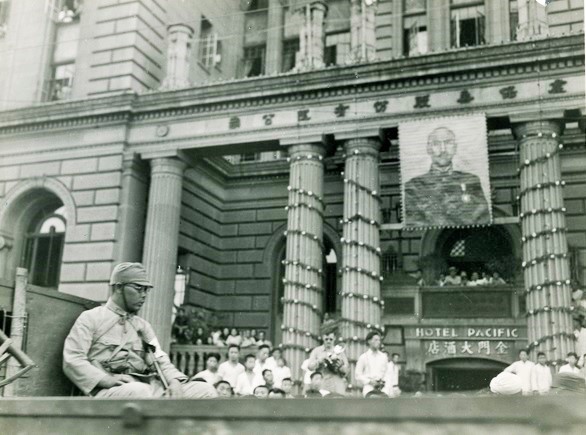
(A Japanese soldier in front of Shanghai’s Pacific Hotel on Nanjing Road in 1945. Chinese people had already hung a poster of Generalissimo Chiang Kai-shek and celebration lights. As of 2019 this building still exists and is still a hotel.)
Besides these two divisions there were other assets in the area. What remained of the IJA’s 69th Infantry Division, having been pulled from combat after heavy losses in central China, was barracked 13 miles west of the Bund in August 1945. Parts of the 118th Infantry Division were in Shanghai; this unit having been dispersed widely in 1945. There was also an Imperial Japanese Navy ashore infantry detachment.

(Nakajima Ki-43III “Oscar” fighters of the IJAAF 48th Sentai near Shanghai after the end of WWII. This sentai was well-equipped even at the war’s end, but critically short of aviation fuel.)
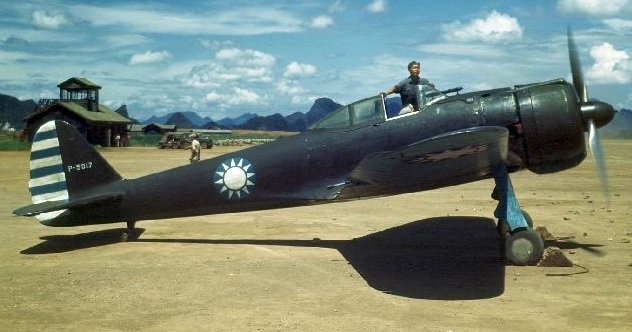
(ROCAF Ki-43I “Oscar”)
China first obtained an intact Ki-43 fighter in 1944, and several in 1945, and then a glut when WWII ended. Eventually by December 1945, two squadrons of the ROCAF (nationalist Chinese air force) 6th Air Group were equipped with Ki-43 “Oscar”s. At that time, Chiang Kai-shek decreed that he wanted all ex-Japanese warplanes out of the ROCAF no later than the end of 1946, but the pressures of the civil war made that impossible and there were still some in service in 1949. Meanwhile Mao’s communists got their hands on five Ki-43s, and the PLAAF did not retire its last “Oscar” until 1952.
Sometimes overlooked today was the 16-day gap inbetween the Emperor’s radio address and the final end of WWII aboard USS Missouri. This was empire-wide, additionally, depending on where they were, Japanese servicemen faced a second gap of days or more until Allied forces relieved them.
For Japanese troops garrisoning occupied areas, this presented a problem. The occupied peoples now knew that Japan had lost the war. Meanwhile Japanese units faced the certainty that they would never be resupplied until Allied forces made contact to take over, and it was unclear what authority and/or responsibility the surrendered IJA still had over the areas. Fortunately for the Japanese troops in Shanghai, there were no large-scale problems.
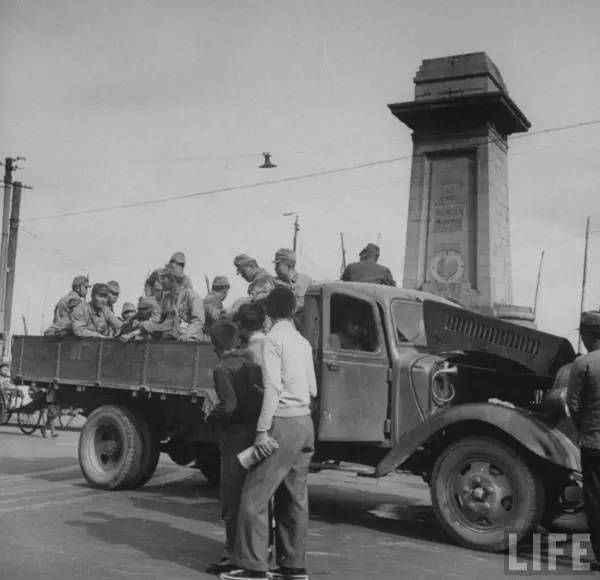
(photo via Life magazine)
In the above photo, demobilizing Imperial Japanese Army troops ride a Type 1 truck in the Bund after the surrender. A military version of the pre-WWII civilian Toyota KB, the Type 1 was shunned by China after WWII. Most were worn out by 1945 and it was not a particularly great military truck to begin with.
Behind the Type 1 is the remains of the peace monument which was erected by Europeans of the International Settlement after World War One. The stone plinth was originally topped by an angel, and the sides by sculptures. During WWII the Japanese removed the angel, sculptures, and brass lettering and wreath off the plinth. It was assumed that they were melted for scrap but 1½ years after WWII, the smashed remains of the angel were found in a Shanghai dump.
The monument was never repaired between 1945 – 1949. After the 1949 communist victory, the plinth was used as a mount for signs and was demolished in 1960. A pedestrian plaza is atop the area in 2019.

(USS Robinson (DD-562) accepted an at-sea surrender of the patrol ship IJN Ataka. A detachment led by Lt. Elmo Zumwalt commanded the Japanese crew to Shanghai in early September 1945. The ship was unwanted by the US Navy and immediately given to China as ROCS An Tung. ROCS An Tung was taken intact by the communists when they captured Shanghai in 1949, and served until the early 1970s. Meanwhile, Adm. Elmo Zumwalt was by then President Nixon’s Chief Of Naval Operations.)
allied forces arrive
On 12 September 1945, a week and a half after WWII ended, nationalist Chinese troops entered Shanghai to relieve the surrendered Japanese troops.

(Soldiers of the Chinese army enter Shanghai in 1945, led by Gen. Tang Enbo. Rifles are the Hanyang 88.)
The Hanyang 88, as carried by the soldiers above, was a bolt-action rifle originating late in the Qing Dynasty as an unlicensed copy of Germany’s 1888 Commission design. Production ran intermittently from 1895 – 1944, with about 1,100,000 being manufactured. It weighed 9 lbs empty and was 4’1″ long. The Hanyang 88 was chambered for the old Patrone M/88 version of the 7.92x57mm Mauser cartridge, with ogive-nosed 198gr bullet (2,600fps muzzle velocity). It used a 5-round internal en bloc. The rear sight was graduated to 160 meters (175yds).

After WWII ended, Hanyang 88s were obsolete but served on during the Chinese civil war as there were simply so many of them still around.
The nationalists used Hanyang 88s all the way up to the defeat in Shanghai in 1949 and final expulsion from the mainland. Some were kept in service in Taiwan into the 1950s as second-line or reserve rifles. For their part, the communists also used Hanyang 88s. After the Korean War they were pulled from frontline PLA service and given to local CPC Militias, where they were in use through the end of the Cultural Revolution in 1971. A few lingered on as training or drill rifles until 1979. Today in the city of Wuhan, the communist war monument is a giant sculpture of a Hanyang 88.
There were several pre-Tiananmen Square import batches of Hanyang 88s to the USA civilian market but it is not a particularly desirable collector’s rifle. Many have barrels shot to oblivion and the rifle overall is half a foot longer and just as heavy as a M1 Garand; another reason the Taiwanese military didn’t retain them for long after 1949.

(Additional nationalist Chinese troops entered Shanghai throughout October 1945.) (photo via Keystone France)
In the above photo, soldiers are carrying M1A1 flamethrowers, M9A1 bazookas, and a M1A1 Thompson SMG.
The M1A1 flamethrower weighed 70 lbs. It carried 5 gallons of napalm and had a maximum range of 47 yards (here, “maximum” meant 50% of the flame reaching the target). The vast majority of WWII American flamethrowers were M1A1s, the difference from the basic M1 being simplified production techniques.
The M9A1 bazooka replaced the M9 in production in 1944. It had an enhanced sight and improved trigger. It was 5’1″ long and weighed 16 lbs. Its M6A3 rocket could penetrate 4″ of steel armor.
The M1A1 Thompson entered production in 1942. It could be assembled in half the time and more cheaply than the earlier M1, M1928A1, and M1921 versions of the famous tommygun. The M1A1 could only use the 30-round box magazine, not the drum of earlier versions.
Some of these weapons were not part of the “official” WWII Lend-Lease authorizations to China by Congress. For example flamethrowers were not legally part of Lend-Lease until late 1944, and during all of WWII only 2,018 bazookas of all types had been authorized to China. Part of the explanation behind this was the work of LtGen. Dai Li, head of Chinese intelligence during WWII. While most men in uniform loathe military bureaucracy, Dai was rare in that regulations and red tape fascinated him and he avidly studied such. He became aware of the US Army’s Theatre Transfer program. This was originally intended in that, if an American unit had a surplus of something and a nearby Allied unit urgently needed it, common sense dictated quick transfer without waiting for Congress half a world away. Dai exploited the Theatre Transfer loophole in the CBI theatre to get quantities of weapons far above what Congress funded for China, and in some cases (like M4 Shermans or M1 Garands) which were not Lend-Lease eligible to China at all. LtGen. Dai Li died in 1946 when a plane he was in exploded mid-air. It is believed that a bomb had been placed aboard, either by a rival in the KMT or by a communist.

(Shanghai in late 1945. The poster has the flags of the WWII allies; the Soviet Union, USA, China, and UK. As the civil war picked up references to the USSR were dropped by the nationalists.)
On 14 October 1945, the KMT restored Shanghai’s civil government, led by a mayor who had been nominated in exile in Chunking. The puppet mayor during the occupation, Chou Fo-hai, was later executed for collaboration despite assurances from the KMT that he would be spared if he managed to keep order inbetween Emperor Hirohito’s 15 August surrender broadcast and whenever Allied forces arrived; which he had done.
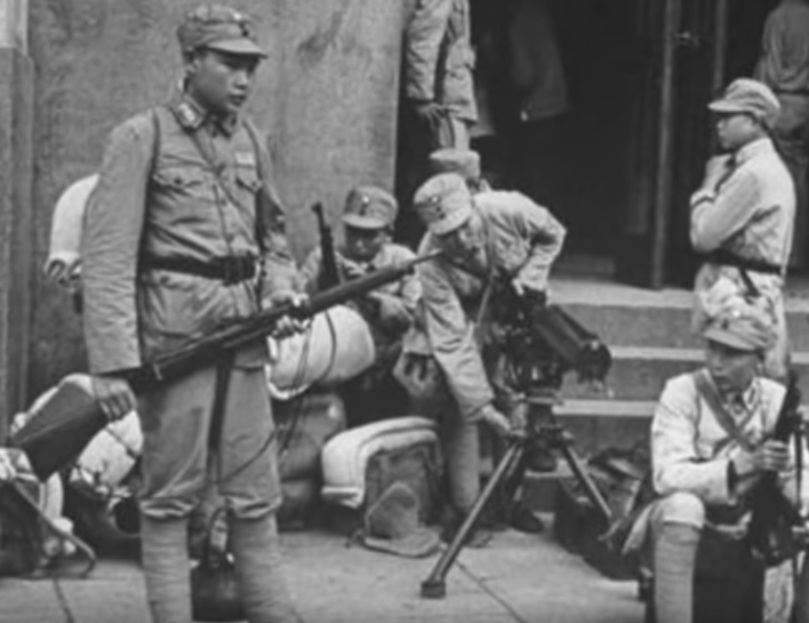
(Nationalist Chinese troops inside Shanghai in late 1945.)
In the above photo, the soldier in the rear has a Chiang Kai-shek Rifle, to his left a soldier with a Type 30 machine gun (an unlicensed clone of the American M1917 but firing 7.92x57mm Mauser rounds from a 250-round belt), and in the corner a soldier with a M1A1 Thompson submachine gun. The soldier in front has a rifle which appears to be a Oberndorf Export Model 1907 but with the turned-down bolt handle associated with the later German 98k of WWII (China also used limited quantities of 98ks during WWII). The Qing Dynasty bought some Mod.1907s direct from Europe, and later China made copies at Gongxian Arsenal as the Type 1 plus some lesser-quality knockoffs at Sichuan Factory and elsewhere. The Chinese Mod.1907s & Type 1s were originally chambered for 6.8x57mm Mauser, but with the introduction of the Type 4 rifle during World War One, this cartridge (unique to China) was abandoned in favor of the worldwide common 7.92x57mm Mauser round. Surviving Mod.1907s and Type 1s were rechambered, and most were also modified with 98k-style features and/or a boss to accept captured Japanese bayonets.
This photo is emblematic of an issue that bedeviled the Chinese army during WWII, and then afterwards the nationalists during the Chinese Civil War: a severe lack of standardization. In 1943, a US Army document counted 750 different weapons in Chinese army use. These ranged from pistols to rifles to machine guns to heavy artillery, but none the less, 750 is an astonishingly high number.
policing Shanghai: VJ Day to 1949
Prior to WWII Shanghai had three police departments: a Chinese police; the “Municipal Police” of Britons, Japanese, Sikhs, and Americans; and a French police. During WWII the USA surrendered its concessionary rights in the city after it would be liberated and pressured Great Britain into doing the same. Germany forced Vichy France to void the French concession in 1943, while Japan’s rights went extinct with the 1945 defeat. Therefore for the first time since 1842, all of Shanghai was under Chinese law in late 1945.

(Shanghai PD officers in the 1945 – 1949 era. Weapons are Thompson SMGs, either M1921 or M1928 models, and M1911 pistol. The officer on the left has a repainted M1 pot helmet.)

(A Willys MB jeep donated by the US Marine Corps to the Shanghai PD after WWII.)
The Shanghai police used a wide variety of WWII items after the war. Along with American-supplied material, surrendered Japanese equipment and items transferred from the Chinese army.

(The Jiaotong was an armored car built from 1945 through 1948. Slow and lightly armored, they were more suited to police or rear-area security use.)

(A Shanghai PD officer in stahlhelm in the Bund during 1947. The civil war was still far from Shanghai at that time. However the police were chronically concerned about riots in the city, and erected numerous sandbagged emplacements around Shanghai so they would be ready at the first sign of trouble.)
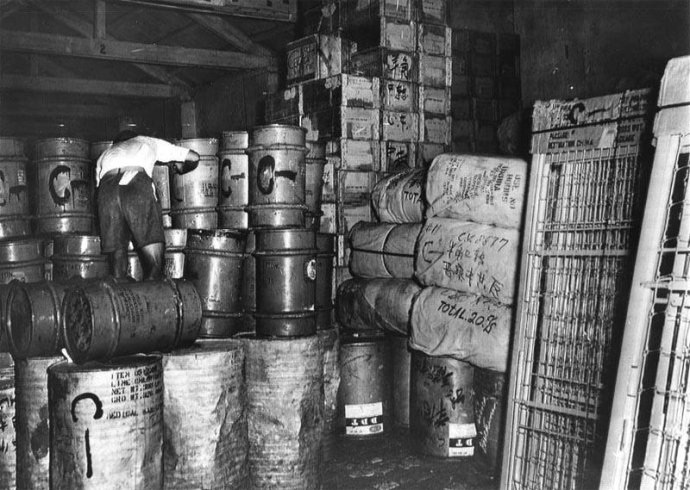
(A ROC Customs contraband warehouse in Shanghai during 1947. The corrugated drums at lower left are WWII US Navy containers which were popular with smugglers.)
The black market was rampant in Shanghai after WWII. Financially fortunate citizens often bought imported American cars or luxury clothes from Hong Kong, not because they particularly wanted them or could afford them, but as a way to salvage their life’s savings from the Yuan’s hyperinflation. A popular black market item for poorer citizens was US Army C-Rations and K-Rations pilfered in bulk from occupied Japan.

(Shanghai PD officers in stahlhelms guard city workers removing two folk-religion statues in 1948. This decision was done to prevent people from clustering in front of the shrine blocking traffic, and was one of several locally unpopular decisions in the 4 years after WWII.)
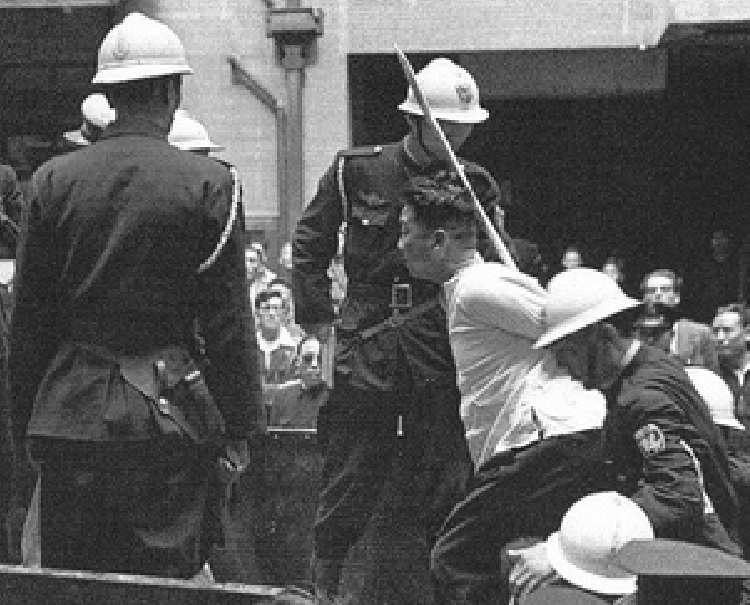
(Shanghai PD officers with a condemned man in May 1949, several days before communist troops began entering the city. Helmets are Mle.26 Adrians. The signboard on the man lists the charges against him.)
The photo above shows Mle.26 Adrian helmets, which was the French army’s model before the 1940 German occupation during WWII. The Adrian was never a Chinese military type and it is possible that the Shanghai PD recovered helmets of the pre-WWII French Concession police in 1945. Capital punishment was always in force in Shanghai after WWII. At first, it covered expected things like homicide and espionage, but gradually grew in scope as the nationalist’s situation deteriorated. By May 1949 counterfeiting, spreading rumors, and speculative investing were all capital charges.
The nationalist Chinese army also had its own military police in the city after WWII ended. These would in fact end up being the city’s final defenders in 1949. Prior to that, their jurisdiction was unclear and sometimes conflicted with the Shanghai police department. In 1947, a massive brawl between Shanghai PD officers and army MPs led to several deaths and thereafter, the Shanghai PD was increasingly positively disposed to Mao’s communists – so much that, by mid-1949, the KMT viewed the department as little more than a fifth column.
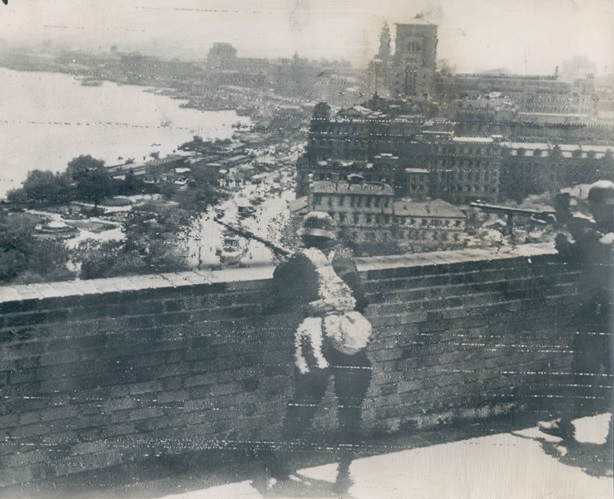
(On 3 May 1949, four weeks before the city’s fall to the communists, army MPs look down on the Bund.)
the US Navy in Shanghai after WWII

(NOB Shanghai, established by the 42nd SeaBee Battalion during the first two months after WWII ended.)
In early August 1945, even without knowledge of the Manhattan Project, a team in the US Navy’s Pacific Fleet had begun planning a presence on China’s eastern seaboard after WWII eventually ended. Of course with the dropping of the two atomic bombs and then the Japanese willingness to surrender in the next two weeks, this happened much sooner than anticipated.
During the interim between Emperor Hirohito’s broadcast and the actual end of WWII, the US Navy’s 7th Fleet created OPLAN 13-45, which was finalized on 26 August. Three flotillas were created for postwar use in China: TF.71, for use in Korea and Soviet-occupied Manchuria; TF.73, a task force of surface combatants and amphibious ships (with a US Marine Corps force) for the Shanghai and Qingdao areas plus the inland Yangtze river; and TF.72, an aircraft carrier group to support the other two task forces.
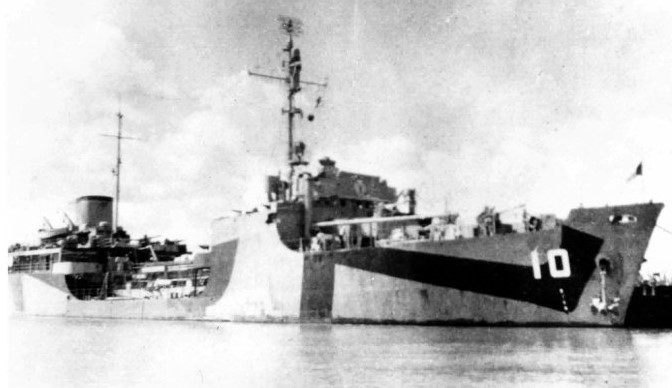
(USS Nemasket (AOG-10) in Shanghai, still with wartime Measure 32/3D camouflage. This veteran of the Iwo Jima and Okinawa battles decommissioned in 1959 and, long mothballed, was finally scrapped in 2006.) (photo by Gil Pollnow)
The first American warship to moor in Shanghai since 1941 was the gasoline tanker USS Nemasket (AOG-10) which tied up on 6 September 1945, four days after the end of WWII.

(The stern of the cruiser USS Nashville (CL-43) alongside USS Rocky Mount (AGC-3) and USS Estes (AGC-12) in Shanghai. USS Nashville would decommission nine months later and be sold to Chile in 1951. USS Rocky Mount decommissioned in 1947 and was scrapped in 1973. USS Estes served in the Korean and Vietnam Wars and was scrapped in 1974.) (photo by Ken Kracht)
On 19 September, half a month after the end of WWII, TF.73 arrived in Shanghai. The task force was led by Adm. Thomas Kinkaid aboard the amphibious command ship USS Rocky Mount (AGC-3) and included cruisers, destroyers, minesweepers, and other types.
Admiral Kinkaid had several objectives, none of which would be easy. The most immediate was to clear Shanghai’s waterways of mines laid by B-29 Superfortresses during WWII.

(The nameless minesweeper USS YMS-370 in Shanghai half a year after WWII. “Whangpoo” is one of several incorrect transliterations of Huangpu used by the US Navy of the era. This ship would be decommissioned four months later and scrapped.) (photo via navsource website)
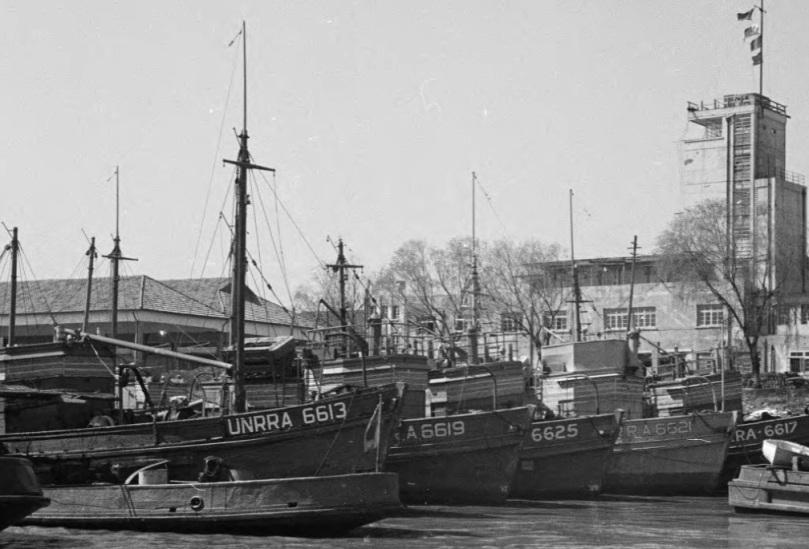
(Trawlers were donated by the United Nations Relief & Rehabilitation Administration to jumpstart Shanghai’s fishing industry as sea mines were swept after WWII. UNRRA was a well-intentioned project but a failure.) (photo by Harrison Forman)
The task force took the surrender of Adm. Tokuji Mori, the final IJN commander in Shanghai. By the end of WWII he had few afloat assets remaining; just two gunboats, some patrol craft, eleven tugboats, and miscellaneous service ships.
One of the most interesting items Adm. Mori surrendered was IJN Tatara. This had been USS Wake (PR-3), a pre-WWII Yangtze river gunboat which was surrendered intact in Shanghai the day of the Pearl Harbor attack in 1941 and managed to survive the whole war. Now in 1945, the US Navy had zero interest in this ship and turned it over to the Chinese.
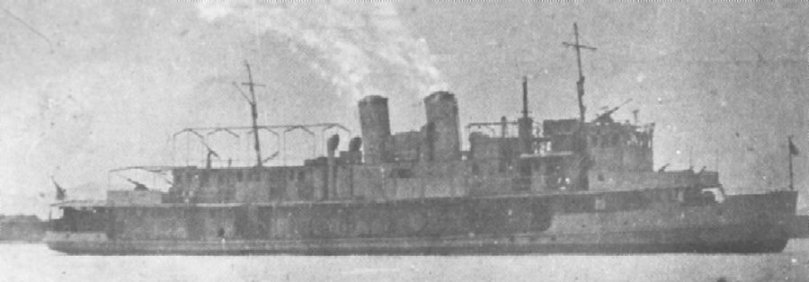
(The ex-IJN Tatara, ex-USS Wake recommissioned as ROCS Tai Yuan as seen above. It was surrendered intact yet again in 1949 when the communists captured Shanghai. A warship surrendering three times in the same decade is remarkable. The communist Chinese navy scrapped the ship in the 1960s.)
Also surrendered were IJN ashore assets including a 150mm artillery piece along with more of lesser calibers, several tanks, around 300 machine guns, some anti-tank guns, over a hundred mortars, and about a dozen AA searchlights. The US Navy did not even bother to count all the rifles and handguns. All of this material was immediately turned over to the Chinese navy.
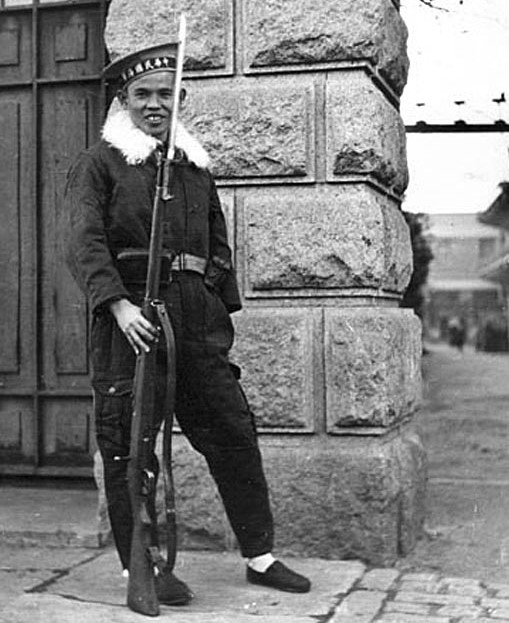
(A sailor of the nationalist Chinese navy in Shanghai during the 1945 – 1946 winter. The surrendered Japanese rifle is a Type I, a somewhat uncommon Japanese WWII rifle built in Italy. Note the “broad D” triggerguard, square hole on the underside, and the typical Japanese ovular bolt handle but placed ahead of the trigger. Japan imported 80,000 of these between 1938 – 1941. All went to the imperial navy. These are not true Arisaka rifles but none the less fired the 6.5x50mm Arisaka cartridge and accepted the Arisaka Type 38’s sling and bayonet.)

(ROCS Chang Chi, formerly IJN Uji during WWII.)
The surrendered patrol ship IJN Uji was one of the first seagoing Imperial Japanese Navy warships which the US Navy in Shanghai transferred to the nationalist Chinese navy. It was handed over as ROCS Chang Chi on 19 September 1945, the first day the full task force was in Shanghai. In 1949 there was a violent mutiny aboard ROCS Chang Chi and the ship defected to the communist side. Recommissioned as Nanchang, the ship was rearmed with combloc guns and radars during the 1950s and served until 1979.
Another mission for Adm. Kinkaid was the repatriation of Japanese out of Shanghai, both tens of thousands of surrendered troops and Japanese civilians. The objective was to get Japanese troops disarmed and back to Japan as quickly as possible, and this started almost immediately. However the process’s end was more protracted: For example what remained of the IJA’s 34th Infantry Division had been fighting south of Nanjing when WWII ended. Critically short of both trucks and fuel, the division commander decided to set out for the coast on foot. The division finally arrived in January 1946, 4 months after WWII ended.
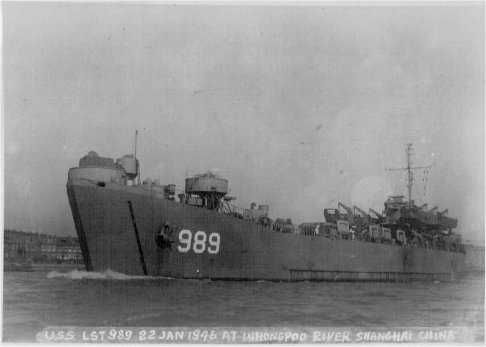
(USS LST-989 on the Huangpu river in Shanghai in early 1946. This nameless WWII amphibious ship decommissioned several months later and was converted for merchant use.)
Amphibious assault ships, such as the tank landing ship above, were used to bring US Marines to Shanghai, both to take the surrender of Japanese land forces and to secure the city until the nationalist Chinese arrived. Some of these ships then repatriated Japanese troops on the return leg. Others were used to reposition nationalist Chinese troops into liberated port cities.

(USS Brevard (AK-164) in Shanghai two months after WWII ended. USS Brevard decommissioned less than a year later and was converted into a merchant freighter in 1947, sailing under various owners until 1970.) (photo via navsource website)
On 22 January 1946, the transport USS Brevard (AK-164) rescued 4,296 Japanese civilians being repatriated to Japan when their ship, the S.S. Enoshima Maru, hit a leftover WWII sea mine near Shanghai. As of 2019 this remains the most people ever rescued at sea by a single ship.
On 1 July 1946, an astonishing 10 months after WWII ended, 532 soldiers of the IJA’s 64th Infantry Division straggled into Shanghai. These would be the last Japanese repatriates out of the city.
The US Navy provided medical services for both its own personnel and the US Marine Corps detachment. Caring for the city was beyond its reach, as Shanghai’s already-large population swelled after WWII from transient Japanese, refugees from the early stages of the Chinese civil war, and newcomers hoping to make a peacetime fortune. In April 1946, Shanghai suffered a smallpox epidemic.

(The hospital ship USS Repose (AH-16) moored at Shanghai. This WWII ship would later serve in the Korean and Vietnam wars.) (photo via Milwaukee Independent newspaper)
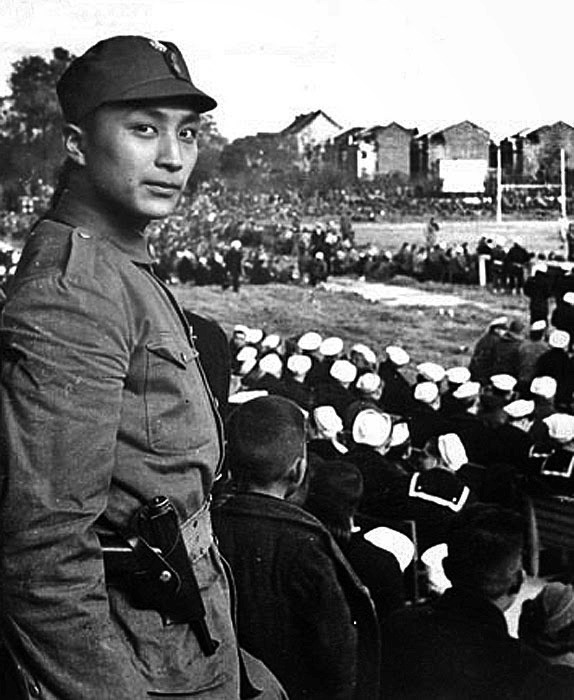
(On 1 December 1945, servicemen of the US Army and US Navy played a football game in Shanghai. This nationalist Chinese army spectator is armed with a surrendered Japanese Nambu Type 14. These handguns were not really popular during the Chinese civil war. No arsenal in China had surviving tooling to make 8x22mm ammunition.)

(A C-46 Commando at Naval Air Station Shanghai, a former Imperial Japanese Army base, in 1947.)

(The nameless USS PCSC-1455 undertook numerous roles during WWII, being capable of patrol, minesweeping, and command functions. From 1945 – 1946 this otherwise-obscure small warship was the designated harbormaster of Shanghai, hence the large pennant number. This ship decommissioned in 1947 and was scrapped in 1970.) (photo by George Herbert Jr.)
During WWII the Chinese navy, with many of its ports occupied, had been a complete non-factor. After the war the United States transferred now-surplus warships to restart it.
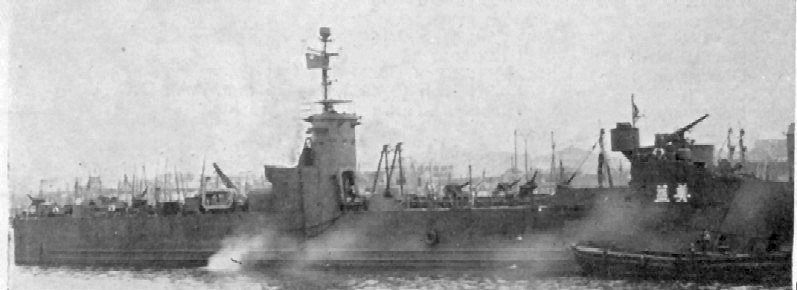
(ROCS Mei Li had been LSM-285 of the US Navy during WWII. This landing ship was transferred in 1946 and served in the Taiwanese navy until 1973.) (photo via navsource website)

(USS Maumee in Shanghai.)
The oiler USS Maumee (AO-2 and later AG-124) was commissioned in 1916 and fought both world wars. USS Maumee was the US Navy’s first large diesel-powered ship and this experiment was overseen by a young Lt. Chester Nimitz, the future admiral of WWII. During WWII the diesels were replaced by a regular steam engine room. From September – November 1945, USS Maumee refueled American and Chinese ships at Shanghai. In November 1946, this old ship decommissioned and immediately transferred to the nationalist Chinese navy as ROCS Omei. Obviously of low combat ability, the big oiler was none the less visually impressive and the Chinese often used ROCS Omei as a “display ship”. ROCS Omei fled to Taiwan in 1949 and served until 1967.
In 1948 a special act, Public Law 512, passed Congress to further bolster the nationalist Chinese navy. A total of 131 surplus WWII warships worth $141,315,000 (about $1.51 billion in 2019 money), unwanted by the US Navy, were given for free. These ranged in size from small landing craft and patrol boats, to big LSTs and included six destroyer-escorts.
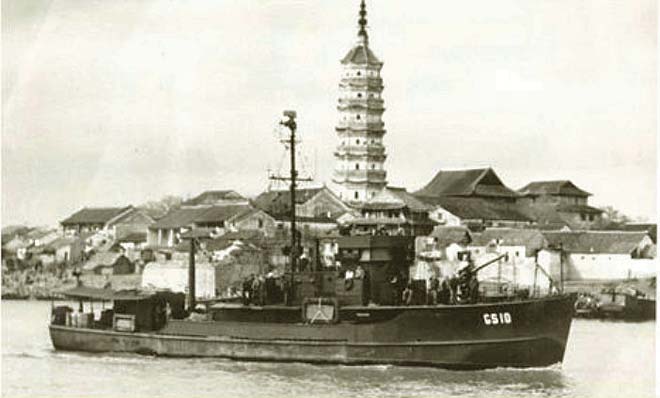
(The WWII-veteran armed survey ship USS John Blish (AGS-10) passing Anqing pagoda on the Yangtze in 1946 while assigned to ComYangPat. As an interesting sidenote, the ship was named after the inventor of the blish lock used on some WWII submachine guns. This ship was scrapped in Baltimore in 1950.) (photo via navsource website)
One fruitless endeavor was the reestablishment of “international patrols” on the Yangtze River. The USA was one of several nations to have this right after the Boxer Rebellion and now after WWII, the US Navy Pacific Fleet established a subcommand, ComYangPat, to resume inland patrols. These accomplished little but aggravated Chinese civilians, who saw the patrols as a humiliation. The patrols were suspended in early 1949 as the Chinese Civil War neared the river, and the subcommand was permanently abolished when Shanghai fell.
CNAC in Shanghai 1945 – 1949
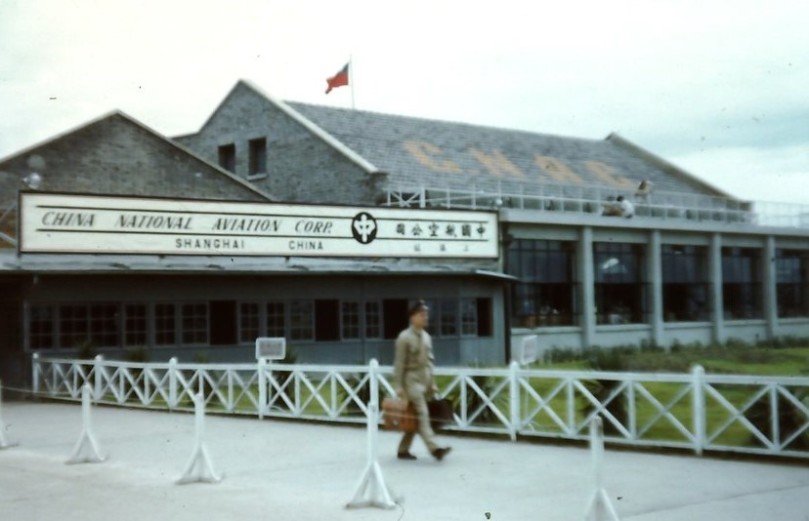
(photo via Business Insider)
China National Aviation Corporation had been China’s main airline prior to WWII and had been based in Shanghai. In 1945, the company returned to the city. The airline was repopulated with now-surplus American military transports, mainly C-46 Commandos and C-47 Skytrains.

(A KMT official boards a CNAC C-46 Commando. In the background is a B-24 Liberator of the nationalist air force and an American C-47 Skytrain.)
As the civil war intensified and the nationalist position deteriorated, lines between CNAC and the military blurred. CNAC planes were increasingly used to fly ammunition to encircled nationalist forces, and the airline’s managing director was a nationalist army colonel.

(Military supplies being loaded into a CNAC C-46.)
CNAC was the last airline to operate out of Shanghai in 1949, with flights not terminating until communist troops approached the airport.
After the nationalists were driven off the mainland, a dozen CNAC planes marooned at Kai Tak IAP in British Hong Kong defected to communist China. Remaining CNAC airliners were sold off to other airlines, while assets in China proper were made state property. That was the end of CNAC.
the rifle of many names
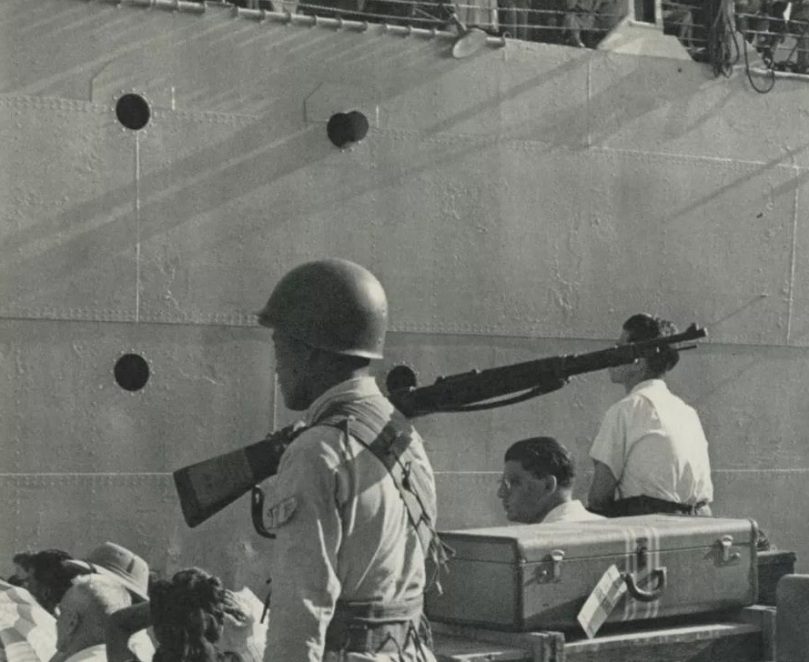
(Nationalist soldier with Chiang Kai-shek Rifle and American M1 pot helmet on the docks of Shanghai, during a 1949 evacuation of European civilians.)
The Type 24 rifle was supposed to have been China’s new standard infantry rifle, however this was never fully achieved during or even after WWII.

This bolt-action rifle was officially designated Type 24, however it is more commonly known as the Chiang Kai-shek Rifle, after China’s WWII leader.

(Generalissimo Chiang Kai-shek (black coat) arrives in Shanghai via an ex-US Army C-47 Skytrain several months after the end of WWII.)
The Type 24 / Chiang Kai-shek Rifle was also called the Zhongzheng Rifle, as later production had the arsenal marking replaced by a banner saying Zhong Zheng Shi, the pinyin spelling of Chiang’s household name, Chung Chen. Alternatively it was called the Generalissimo Rifle, especially in English. Finally, after the Chinese Civil War, examples in communist China were redesignated Type 79 in the PLA nomenclature system. Many communist soldiers also scratched off the Zhong Zheng Shi marking for obvious reasons.
The Chiang Kai-shek Rifle was based on the 1920s German “Standardmodell” rifle. It weighed 9 lbs and was 3’8″ long, with iron sights. It fired the 7.92x57mm Mauser cartridge (2,657fps muzzle velocity) from a 5-round stripper-fed magazine.

(HY1935 bayonet and scabbard. There was also a cheaper leather scabbard used.) (photo via worthpoint)
This rifle was designed for the HY1935 bayonet. There were not enough of these and after WWII, thousands of surrendered Japanese bayonets were adapted by removing the blade and remounting it onto a cheap Chinese-designed handle. The Chiang Kai-shek Rifle was designed for a leather sling. During WWII this was changed to a cloth sling, and still later, slings were made of recycled Canadian shipping strap.
This rifle was produced from 1935 – 1949. During the 1949 battle for Shanghai, this was more or less the de facto “standard issue” longarm for both the nationalists and communists, matched by a probably equal number of mixed American and Japanese rifles. The Chiang Kai-shek Rifle served long after Shanghai fell. In Taiwan, the nationalists used it into the late 1950s and in reserve units into the 1970s, and in 2019 it is still a parade rifle along with the M1 Garand. Meanwhile in China, the weapon appeared commonly during the Korean War and was a standard PLA rifle into the late 1950s. It remained in use with reserve and CPC Militia units until 1980.

(Communist soldier with Chiang Kai-shek Rifle, or Type 79 as it was redesignated by the PLA, in Shanghai’s Bund during May 1949. The soldiers are riding the carriage and runout cylinder assembly of a surrendered Japanese Type 4 howitzer. The actual gun portion of this 150mm weapon was carried on a second cart to lessen the load on the horse. Only 280 of these howitzers were made by Japan and they were a prized post-WWII item in China, even though they were unsuitable for motorized towing.)
In the modern collectors market, a Chiang Kai-shek Rifle normally fetches anywhere between $200 – $900 depending on its condition.
WWII American rifles in Shanghai after 1945

(Nationalist sentry with M1917 on the Shanghai docks during early 1949.)
The M1917 rifle, also called the “American Enfield”, was the first and main rifle made eligible for WWII Lend-Lease to China by Congress, with deliveries starting in 1941 and running throughout WWII. A total of 152,241 were delivered which is slightly more than all other Lend-Lease rifles of all types combined from both the USA and UK.
The bolt-action M1917 was 3’11” long and fired the .30-06 Springfield cartridge (2,800fps muzzle velocity) from a 5-round internal magazine. It was a well-built rifle, overshadowed in popularity by the M1903 Springfield before it and M1 Garand after it.

(Nationalist soldier with M1917 during the 1949 battle for Shanghai.)
Congress originally intended the M1917 to be the sole Lend-Lease rifle for China however the need eventually outstripped the supply and M1903 deliveries began. None the less, 1 out of every 14 of all M1917s ever manufactured ended up in China. During the Chinese Civil War, nationalist troops generally regarded it as second-rate; with the guns themselves often showing wear from WWII use.

(Nationalist soldier with M1903 Springfield during the 1949 battle for Shanghai.)
As mentioned, Lend-Lease deliveries of M1903 Springfield rifles began to supplement M1917s during WWII. Eventually 107,470 were shipped to China plus several thousand more after WWII.
This excellent bolt-action rifle fired the .30-06 Springfield cartridge (2,780fps muzzle velocity) from a 5-round stripper-loaded magazine. The Springfield weighed 8¾ lbs and was 3’8″ long. The M1903 was the USA’s standard service rifle during the first world war and a substitute standard during the second; and even at the end of the 1940s it was a well-regarded firearm worldwide. These were liked by nationalist troops and the M1903 remained in Taiwanese use into the 1970s.

(As the battle rages on the outskirts of Shanghai in 1949, a nationalist roadblock watches a M3 Stuart tank pass. Rifles are a M1941 Johnson and an Arisaka Type 38. Mixtures of American and Japanese WWII arms were common during the Chinese Civil War.) (photo via University Of Wisconsin)
The M1941 Johnson rifle was originally proposed as a supplement or replacement to the M1 Garand. On paper at least, it was certainly equal and questionably better than the Garand, however any advantages were too trivial to justify disrupting the Garand production and training programs. Hence only about 70,000 were ever made.
The semi-automatic M1941 Johnson fired the .30-06 Springfield cartridge (2,840fps muzzle velocity) from a clever 10-round belly magazine which was loaded via two M1903 Springfield strippers. It was 3’10” long and weighed 9½ lbs.

(Communist troops appreciated the M1941 as much as the nationalists and used any captured examples.) (photo by Vladislav Mikosha)
Congress authorized a grand total of zero M1941 Johnsons to China, yet, hundreds if not thousands ended up there. This was most likely due to the efforts of LtGen. Dai Li, as mentioned earlier.
other WWII infantry weapons in Shanghai
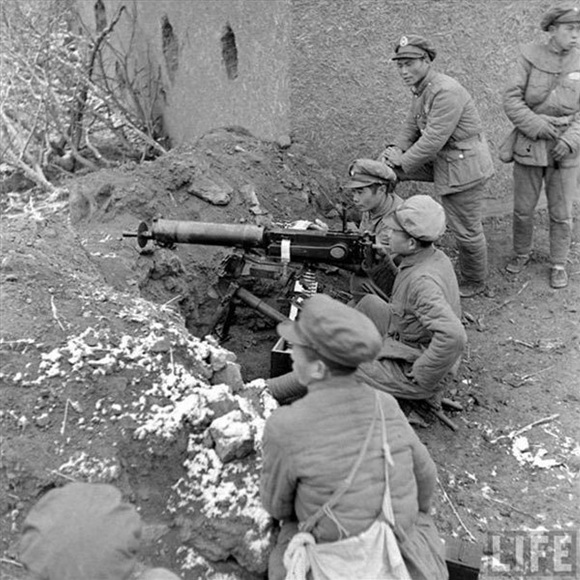
(Nationalist Type 24 squad in action during 1948.) (photo via Life magazine)
The Type 24 was by a wide margin, the main Chinese machine gun during WWII and the Chinese Civil War, where both sides used it. The Type 24 was Hanyang Arsenal’s unlicensed half-breed of the German MG-08 and Maxim 1909 Commercial designs, firing the 7.92x57mm Mauser cartridge from a belt feed system. The disc behind the flash hider on the muzzle deflected exhaust from the gun’s recoil booster portals. By 1949 some Type 24s were missing the disc.

Taken in 1949, the above photo shows members of a communist militia using what is often called an “Ingals Chinese” or “Chinese Bren”. During WWII, John Ingals & Co. in Canada was contracted to make 43,000 Bren light machine guns for China, but chambered in 7.92x57mm Mauser instead of .303 British. Other than the cartridge change, the design was basically a Bren Mk.I but with a few simplified production techniques. The guns were numbered with a _CH___ series and had Mandarin lettering. The digit before CH indicated the year of manufacture; 1 for 1943, 2 for 1944, and 3 for 1945.
For the USA’s contribution to this project, Western Cartridge was contracted to make 7.92 Mauser ammo for the guns; probably the only American military order in that caliber during WWII. It is unclear how much (if any) made it to China before Western merged into Olin late in WWII.
Of the 43,000 ordered, only 18,900 made it to China by the end of WWII with several thousand more during the Chinese Civil War. Part of the contract was possibly instead rolled into the unrelated so-called “Sterile Bren” program, barely-marked guns intended for clandestine distribution.
“Chinese Bren”s were highly popular guns in the Chinese army as they were similar to the ZB vz.26, the standard Chinese LMG of WWII, which also used 7.92 Mauser ammo. Both sides used them during the Chinese Civil War.
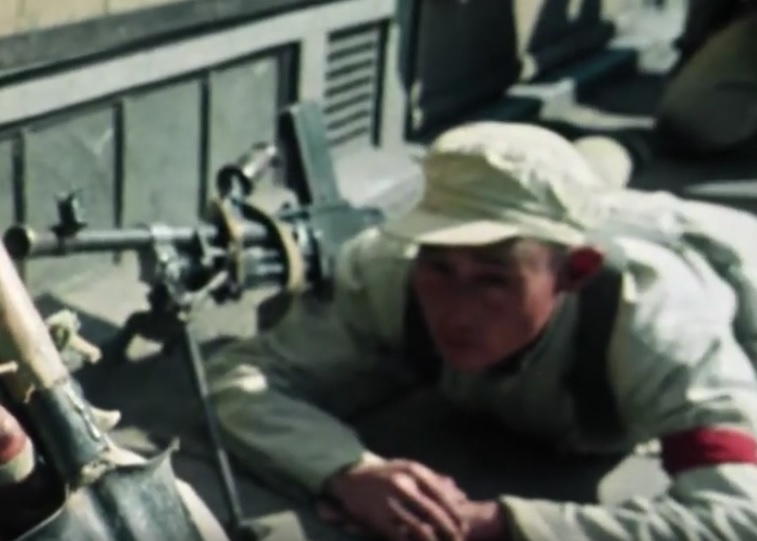 (Communist infantry advancing inside Shanghai with a “Chinese Bren” during May 1949.)
(Communist infantry advancing inside Shanghai with a “Chinese Bren” during May 1949.)
The Mauser-chambered Brens continued in use with both sides after the Shanghai battle. During WWII, the UK had also Lend-Leased China about 4,700 regular Brens in .303 British. These were less popular due to the nonstandard ammunition and in the 1950s, the PRC modified some to 7.62x39mm Soviet using AK-47 magazines. Meanwhile during the early 1950s, the nationalists on Taiwan made a Bren clone called the Type 41 chambered for .30-06 Springfield.

In the above photo, a communist soldier mans an ex-Japanese Nambu Type 92 in 1949. This air-cooled machine gun fired the 7.7x58mm Arisaka cartridge at 450rpm. During WWII the 7.7mm Type 92 was an adaptation of the 6.5mm Type 3 machine gun, following the Imperial Japanese Army’s shift from the 6.5mm Type 38 rifle to the 7.7mm Type 99.
A shortcoming inherited from the Type 3 was the feed system. The Type 92 used a 30-round tape which moved horizontally left-to-right through the receiver. The tapes were made first of brass, then as Japan’s WWII fortunes declined, scrap steel and finally oiled cardboard. In a sustained trigger pull, the tape exhausted in about 4 seconds which was significantly shorter then the time required for the gunner to interlace a new tape into the receiver. If the tapes were not kept clean and oiled, the Type 92 also tended to jam.
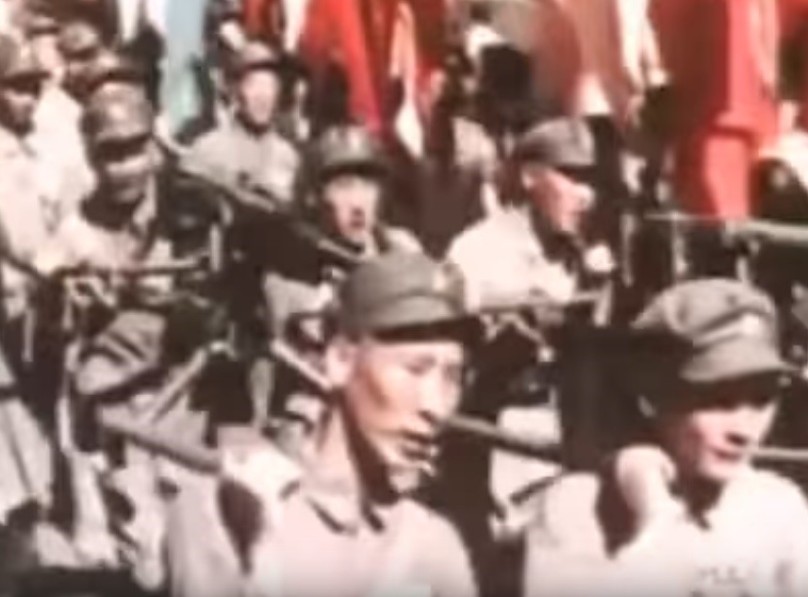
The Type 92’s tripod had sockets for carrying poles, so the weapon could be moved combat-ready as seen above. This photo was taken during the communist advance from Nanking towards Shanghai in April 1949, and judging by all the flags, may have been a propaganda re-enactment.
WWII warplanes over Shanghai 1945 – 1949
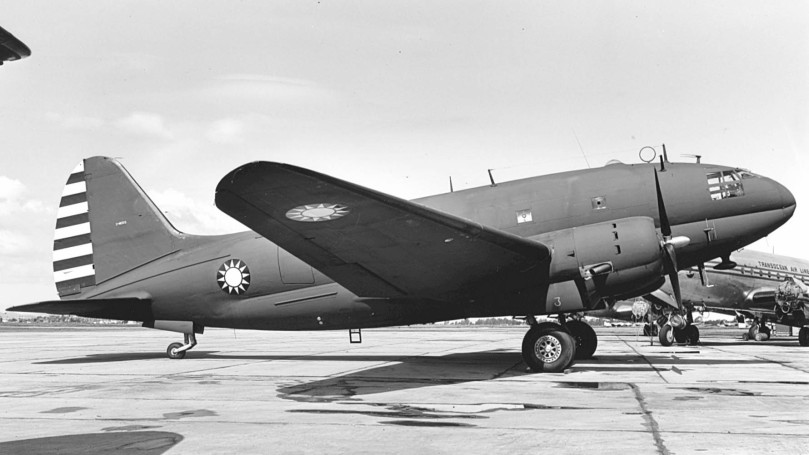
(Nationalist C-46 Commando during the Chinese Civil War, formerly of the US Army. The nationalists used this WWII transport all the way through the defeat in Shanghai and then exiled in Taiwan, into the late 1960s.)
Immediately after the end of WWII, the USA began to bolster the ROCAF (nationalist air force) which had taken quite a pounding during the war.
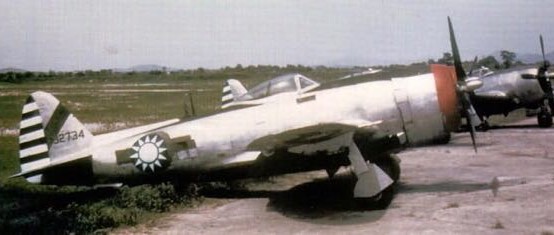
(Shortly after Japan’s surrender in 1945, much of 81st Fighter Group was transferred to the ROCAF. This P-47 Thunderbolt has nationalist Chinese markings over painted-out American insignia.) (photo by Larry Davis)
The P-47 Thunderbolt was a mainstay of the nationalist effort in Shanghai between 1945 – 1949. It was capable of just about any mission and was most commonly used in the fighter-bomber role.
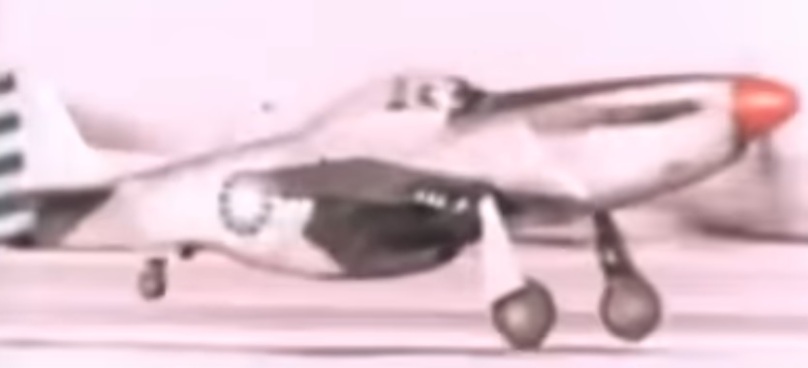
(Nationalist P-51 Mustang defending Shanghai in 1949.)
Surplus P-51 Mustangs arrived in greater numbers after the end of WWII and bolstered the nationalist air force.

Along with twin-engined B-25 Mitchells, the four-engined B-24 Liberator was the main nationalist bomber of the Chinese civil war, undertaking both tactical and strategic missions, in addition to anti-shipping missions and supply drops. The USA had marked the Liberator for elimination from the post-WWII US Army (soon to be the independent US Air Force) so exports were more forthcoming than was typical of strategic bombers.
The B-24 shown above was involved in a curious incident on 3 February 1949. Based in Shanghai, a group of ROCAF turncoats waited until the ground security watch was turning over for their lunch break, and absconded with the Liberator, defecting to a communist-held airstrip in Hebei province. It was immediately placed into service with the PLAAF (communist Chinese air force) as shown.
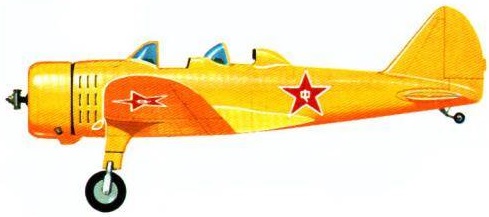
(The PLAAF flew ex-Japanese Ki-79B “Nate” fighter-conversion trainers from 1946 – 1949. These had most likely been captured intact by the USSR in 1945 and then passed on.)
Mao’s communists essentially started from zero in 1945 when it came to air power, but gradually built up an air force, first with donated ex-Japanese planes from the USSR, then ex-Soviet planes, and finally an ever-increasing stream of defectors from the nationalists.

(The PLAAF grew steadily with defecting ROCAF planes, which turned into a flood in 1949 when it became clear that the nationalists were going to lose.)
The above photo, taken in 1949, shows an impressive display of “capitalist-world” WWII warplanes delivered to Mao’s communists by defecting nationalist pilots over the previous four years: P-51 Mustangs, P-47 Thunderbolts, a Mosquito FB.26, L-5 Sentinels, B-25 Mitchells, C-46 Commandos, and C-47 Skytrains.
Arisakas in Shanghai after 1945
After Japan’s defeat in September 1945, surviving Japanese weaponry (of which there was a lot) was generally shunned worldwide, with a few exceptions; Thailand, the Viet Minh in French Indochina, Indonesian rebels, the new nations of North and South Korea, and – above all – China. Both the nationalists and communists in the Chinese Civil War made massive use of ex-Japanese weaponry; just because so much of it had been marooned on Chinese soil when WWII suddenly ended.

(Communist soldiers with Arisaka Type 38 rifles, Type 30 bayonets, and M30-32 Tetsu-bo helmets in 1949; all surrendered Japanese gear.)
During WWII, Japan fielded two main types of standard service rifle: the Arisaka Type 38 and Arisaka Type 99. The Type 99, which existed in limited numbers in Shanghai after WWII, was the newer of the two designs and a bolt-action rifle firing the 7.7x58mm cartridge.
The Type 38 was more common in the Chinese theatre during WWII. Adopted in 1905, the Type 38 remained in limited production even after the Type 99 entered service in 1939 and in fact, the last of approximately 3,400,000 made rolled off the assembly line in 1944. The Type 38 was a bolt-action rifle 4’3″ long and weighing 9¼ lbs. It fired the 6.5x50mm Arisaka cartridge (2,500fps muzzle velocity) from a 5-round internal magazine. It had iron sights and was effectively accurate to 492 yards.
 The Type 38 was well-designed for its era, with a sturdy, smooth bolt. However by WWII, it had been left behind by the worldwide shift to rifles of more manageable length. The 6.5x50mm cartridge’s 139gr FMJ bullet, although having good muzzle velocity, lacked stopping power compared to WWII contemporaries like .30-06 Springfield, .303 British, and 7.92 Mauser.
The Type 38 was well-designed for its era, with a sturdy, smooth bolt. However by WWII, it had been left behind by the worldwide shift to rifles of more manageable length. The 6.5x50mm cartridge’s 139gr FMJ bullet, although having good muzzle velocity, lacked stopping power compared to WWII contemporaries like .30-06 Springfield, .303 British, and 7.92 Mauser.
Even before the Chinese Civil War, the Type 38 was no stranger to Chinese use. During the course of the Sino-Japanese War and then WWII, captured examples were pressed into service and there was also an unlicensed copy, the Shanxxi Six/Five Rifle, of which 108,000 were made.

(Nationalist troops outside of Shanghai during 1948. The rifles are ex-Japanese Type 38s. The light artillery piece is an ex-Japanese Type 94. It fired a 75x294mm(R) round out to 5 miles. The trails could be disengaged to allow the crew to push it short distances with poles, as shown. The helmets are ex-Japanese Tetsu-bos.) (photo via Life magazine)
What kept the Type 38 going in China years after WWII was a ready supply of 6.5 Arisaka ammo. Out of production everywhere else (including Japan) worldwide after August 1945, low-scale production in China continued in 1945. The nationalists restarted mass production in 1946, and then the communists in 1948. This was on top of the hoard of Japanese-made 6.5mm ammo the nationalists secured intact when WWII ended, and the large quantity the USSR gave to Mao’s communists in Manchuria.

(Nationalist soldier with a Type 38 at a checkpoint leading into Shanghai.)
The nationalists lost the ability to manufacture 6.5 Arisaka ammo when they fled the mainland in 1949. They retained a stockpile on Taiwan for the remaining Type 38s evacuated to the island for a few years. Meanwhile the PRC continued production until midway through the Korean War, around late 1951 – early 1952, when non-combloc calibers were suspended. China retained stock of 6.5 Arisaka into the 1970s.
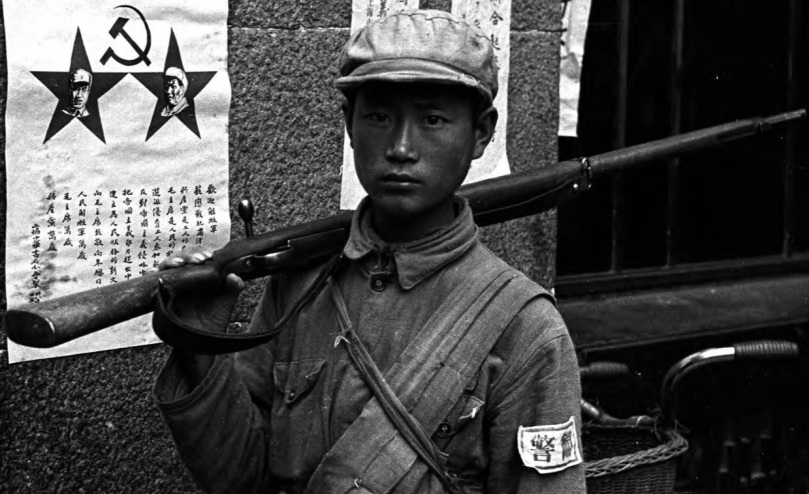
(Communist soldier with Type 38 inside Shanghai during the final 1949 battle for the city. The poster shows Gen. Zhu De and Chairman Mao. A former 1930s warlord, Zhu became a communist general and later a field marshal in the PLA. He passed away in 1976.)
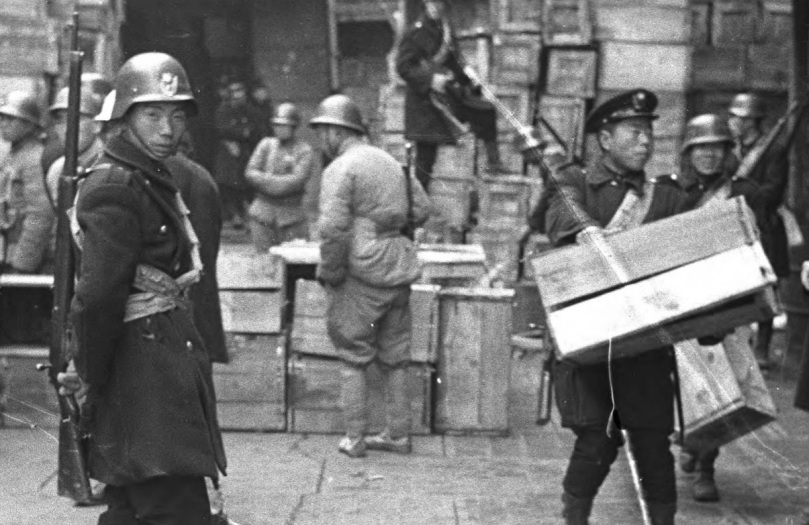
(Nationalist army MP with stahlhelm and Type 38 in Shanghai in early 1949, guarding crates of money before the city fell. The men in Tetsu-bo helmets are nationalist marines.)
The above photo is symbolic of the way nationalist rule in Shanghai ended in 1949. In a bid to lift the spirits of the city as communist armies approached, the KMT simply used the oldest trick known and handed out wads of free cash. A shipload of banknotes was distributed by the nationalist military. It was discovered that some people receiving the cash were deserters from the defeats in northern China; also there was no mechanism (other than time and patience) deterring residents from going through the line two or three times. The project was halted. Meanwhile the influx of money without any increase in goods to buy exacerbated inflation in Shanghai’s economy.
WWII-era tanks in Shanghai
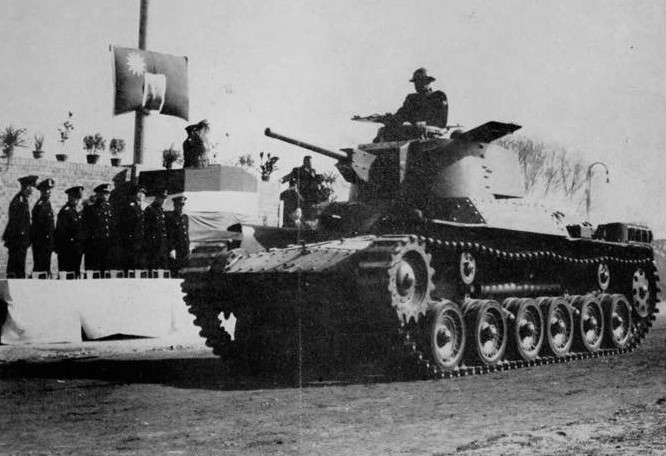
(A nationalist Type 97 Chi-Ha on parade in Shanghai in 1949. Both the nationalists and communists – but especially the latter – made use of ex-Japanese tanks. On the dais is Gen. Tang Enbo, discussed further later.)
The role of tanks during the defense and capture of Shanghai is often overlooked, as during the final push into the city’s core, the communists forbade use of medium- and large-caliber guns to avoid wrecking the city. None the less, they did play a part in the story. The nationalists had a combined 300 tanks of American, Japanese, and Soviet design in Shanghai in 1949.

(Fahnenjunker Chiang Wei-kuo in Wehrmacht uniform with Schützenschnur award.)
Generalissimo Chiang Kai-shek’s son Chiang Wei-kuo received military training in Germany from 1936 – 1939. He received no special treatment and was by all accounts, a good soldier and popular with his German comrades. Chiang participated in the annexation of Austria and was due to lead a panzer unit in the planned invasion of Poland, but was recalled to China before that.
Now in 1949, Chiang Wei-kuo was a lieutenant general in the nationalist army, leading a tank regiment of American-made M3/M5 Stuart tanks in the defense of Shanghai.
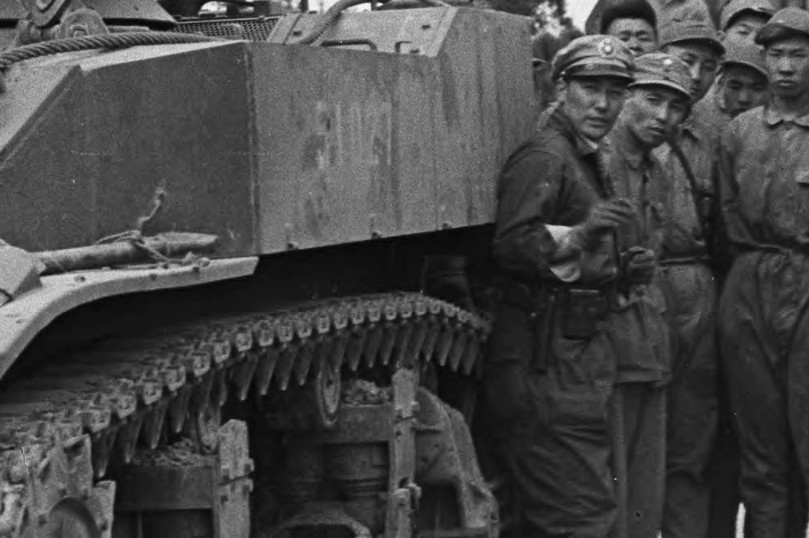
(LtGen. Chiang Wei-kuo with a Stuart tank in Shanghai during 1949.)
During 1949, Chiang crafted two plans for “offensive defense” of Shanghai. The first was to be a German-style attack led by tanks. A communist spy revealed the plan and it was called off. The second was a more complex idea; here nationalist tanks would puncture the communist infantry lines west of the city then move in a southeast – east – north loop, destroying the communist’s artillery and logistic units. As the communist infantry encircling Shanghai doubled back to defend their rear area, nationalist infantry in the city would then attack them from that side. Chiang reasoned that the plan might result in heavy losses to his tanks but if successful, would buy months of time to either reinforce or evacuate remaining nationalist forces in Shanghai. By 1949, that was probably as much as anybody could hope for. The day of the attack, poor coordination by the infantry units resulted in the plan being cancelled at the last moment. Chiang was then himself evacuated to Taiwan.
After the loss of Shanghai, Chiang commanded a tank unit in Taiwan and later rose to full general. During the early 1960s, Chiang Kai-shek ordered Chiang Wei-kuo to draft a warplan called Gúoguang; a massive invasion and reconquest of southern China. Had it actually been tried, this pie-in-the-sky idea would have certainly failed and probably would have ended in a communist takeover of Taiwan. Although he dutifully obeyed the order and wrote the plan, Chiang Wei-kou himself was lukewarm to the idea. None the less, he had the misfortune of having his name on it and was never again influential in the Taiwanese military. He spent his later career concentrating on trade ties between West Germany and Taiwan, and passed away in 1993.
The M3/M5 Stuart tank was commonly seen in Shanghai after WWII; the most common versions in the city being the M3A1, M3A3, and M5A1. All were armed with a 37mm M6 main gun, with 147 rounds of ammunition. All had a 4-man crew.

(Wounded nationalist infantry walk past a M5A1 Stuart on the outskirts of Shanghai in early 1949.) (photo by Harrison Forman)
M3 versions had already been provided to China as Lend-Lease during WWII; after WWII more came as direct aid or as open purchases by the nationalists. M5 versions began arriving later during the Chinese Civil War, with about 100 of this version being delivered. Some M5s were obtained from a pool of Stuarts left in the Philippines at the end of WWII and now unwanted by either that country or the USA.
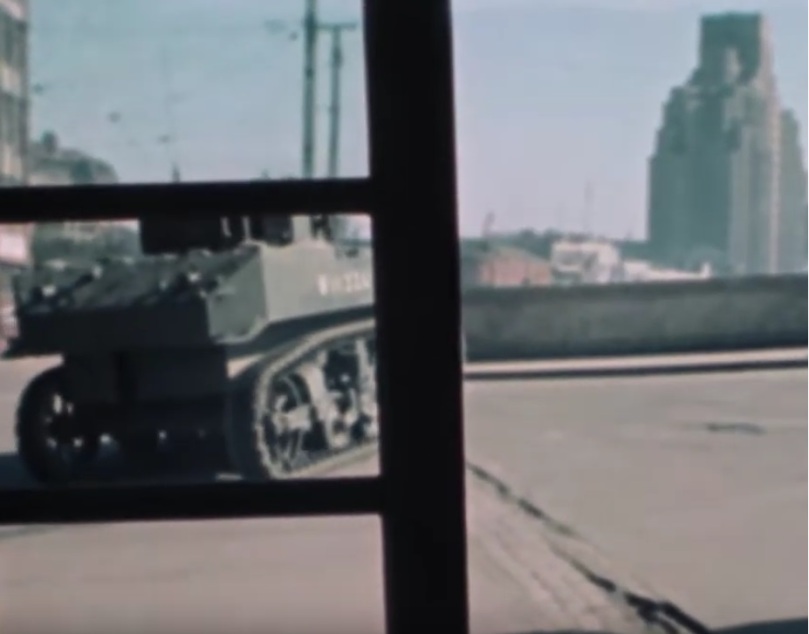
(A communist M3A3 Stuart on the north end of Zhapu Road Bridge during the final week of May 1949. The tank was not targeting the Broadway building but rather acting as a roadblock on the bridge.)
Captured Stuarts, along with Chi-Has and Ha-Gos leftover from the defeated Japanese, formed the nucleus of the People’s Liberation Army’s tank corps during the Chinese Civil War.
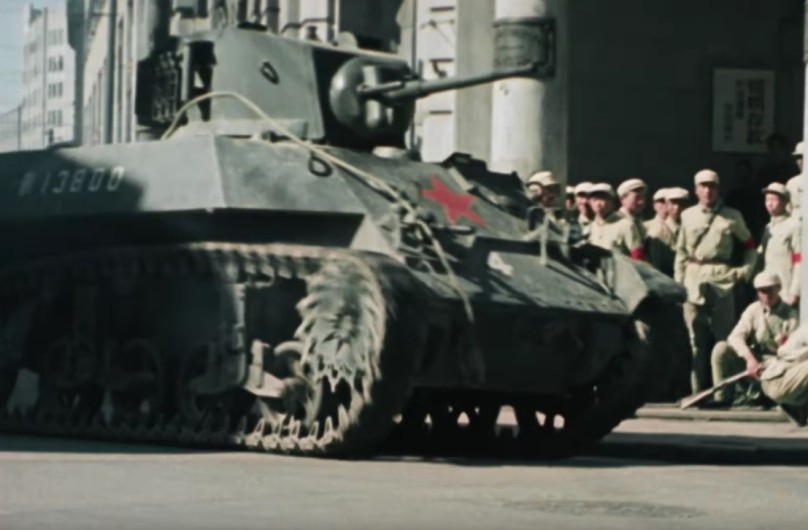
(A communist M3A3 Stuart in the Bund during the PLA’s second reinforcement & repositioning phase, which happened four months after Shanghai fell. The tank was described as a “liberated M5” but has the weatherproof light cap on the turret roof meaning it was a M3A3. The communists often retained the nationalist serial number on the sides of captured tanks.)
One of the more surprising tanks to see combat in Shanghai in 1949 was the T-26. This pre-WWII 10-ton light tank had entered Soviet army service in the early 1930s and fought against the Germans until early 1944 when it was yanked from combat as being dangerously obsolete. It was armed with a 45mm 20K anti-tank gun with 122 rounds of ammo, a coaxial machine gun, plus a DT 7.62mm machine gun in a rearwards-facing flexible turret mount. The T-26 was very lightly armored by WWII standards; in no place more than ¾” and ¼” or less in most areas. It had a 3-man crew and was slow, with a top speed of just 14mph on roads and 9mph cross-country.

(Nationalist T-26s on the Shanghai docks being prepared for evacuation to Taiwan in early 1949.)
The Soviet Union had sold 88 of these tanks to the nationalist Chinese government in 1938. Despite China’s terrible tank losses during WWII, a surprising number still survived in 1945 to fight in the Chinese Civil War. Most were in nationalist hands but a few captured examples were used by the communists.
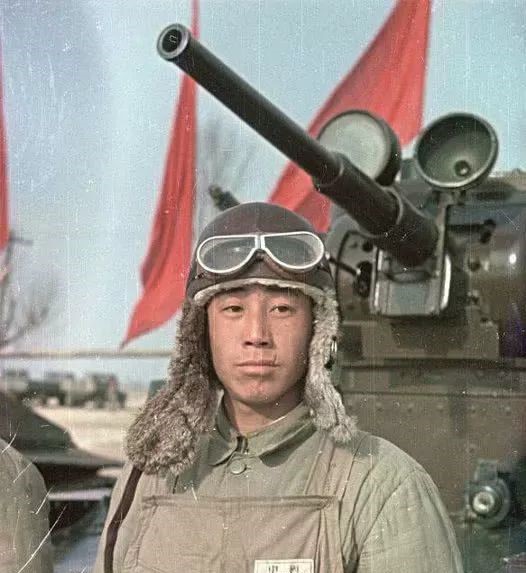
(Communist T-26 crewman in early 1949.)
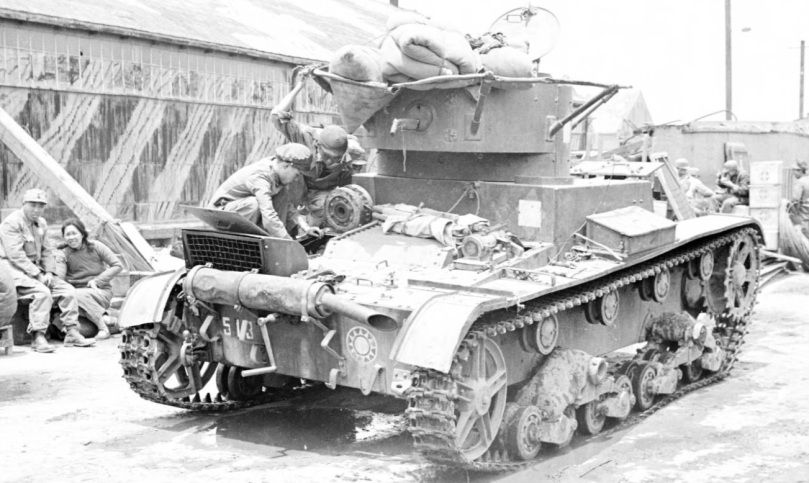
(A beat-up nationalist T-26 being serviced at the Shanghai ferry terminal in 1949. The “halo” radio antenna is broken and being used as a cargo rack, the rear-facing machine gun barrel is bent, and other parts of the tank are dinged and dented. The T-26 was handcrank-started as shown.) (photo by Harrison Forman)
Although some of the nationalist T-26s in Shanghai were evacuated to Taiwan in May 1949, they were soon out of service there. Meanwhile the PLA had no desire to keep the type and soon retired theirs as well. The 1949 battle for Shanghai was the last hurrah for this tank.
the tommygun in Shanghai after WWII
The Thompson submachine gun, in various models, was a key firearm for both the nationalist and communist forces in the Chinese Civil War. A total of 20,856 of all versions had been Lend-Leased during WWII with thousands more coming afterwards.

(A 1949-edition Chinese parts guide for the M1928A1 Thompson. This had been the first version authorized by Congress for Lend-Lease to China during WWII, although earlier M1921 and M1928 versions were already in the country by various means.) (photo via machinegunboards web forum)

(Nationalist soldier in Shanghai during the winter of 1948 – 1949. Firearm is a M1 Thompson. The M1 version, which could only use the box magazine, was an American WWII effort to reduce the tommygun’s price tag by omitting the cutts compensator, cooling fins, and adjustable sight, with the bolt handle moved to the side.)
The Thompson weighed between 10 to 10½ lbs depending on the version and was full-auto at 700rpm. It used the .45ACP cartridge (935fps) from either a 100-round drum, or 20- / 30-round “stick” magazines depending on the version.
Taiyuan Arsenal made a number of unlicensed M1921 copies in the 1930s but they were unsuccessful. The communists later made a tommy half-clone but chambered in 7.62x25mm. Otherwise all the Thompson submachine guns in China came from the USA.
China had been low-rate producing .45ACP ammunition at Sichuan Factory and then other locations since 1930. After WWII ended, mass production started and by 1947 over 1 million .45ACP rounds were manufactured in China monthly. After the nationalists were driven from Shanghai and the mainland in 1949, the PRC continued making .45ACP (which it called “11x32mm Pistol”) until the mid-1950s. This was all of course on top of ammunition supplied by the USA after WWII.
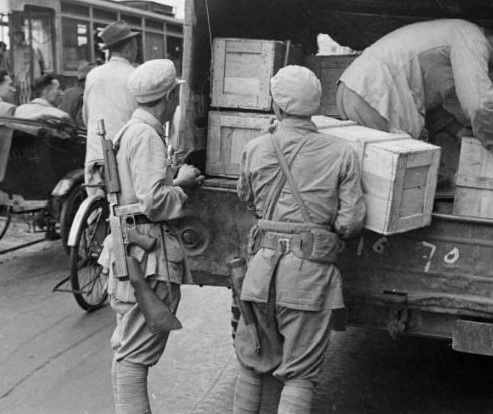
(Communist troops unload supplies in Shanghai in 1949 after the city’s capture. The firearm is a M1928A1 Thompson.)
Thompsons continued in use in both China and Taiwan after 1949. During the Korean War, they were one of the more common weapons captured from Chinese troops.
the end of nationalist Shanghai

(One of the last large US Navy warships to make a friendship visit to Shanghai was USS Astoria (CL-90). This WWII cruiser visited in December 1948. USS Astoria decommissioned six months later and was scrapped in 1971. The classical building in the lower left was the USSR’s consulate. As of 2019 this building still exists and is the Russian Federation’s consulate.) (photo via Life magazine)

(Nationalist Studebaker G630 military trucks at the Shanghai railway depot in December 1948, on their way to the front lines. About 200,000 of these 6×6 trucks were built in the USA, with production ending when WWII ended.)
By mid-January 1949, communist troops controlled pretty much all of China north of the Yangtze river except for besieged enclaves in Tianjin and on the Shandong peninsula.
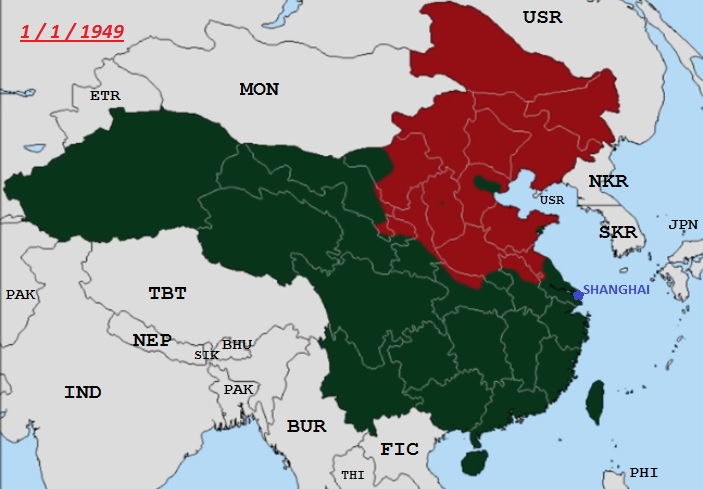
During April 1949, the communists began to mass forces on the north bank of the Yangtze in China’s interior.

(In early 1949, the neutral British warship HMS Amethyst was crippled by communist artillery while patrolling the Yangtze river. The heavy cruiser HMS London, a veteran of the chase of the Bismarck during WWII, was sent upriver as a show of force. The communists were not impressed and hit the big cruiser – way out of its intended element – with field artillery and anti-tank guns. HMS London stopped in Shanghai as seen above for emergency repairs to allow safe transit to a shipyard in Hong Kong.)
During a 36-hour span on 20 – 21 April 1949, nearly a third of a million communist troops crossed the Yangtze in junks and rafts. The nationalist response was disastrous. The nationalist navy’s 2nd Fleet, which had been assigned defense of the Yangtze, defected to the communists almost en masse.
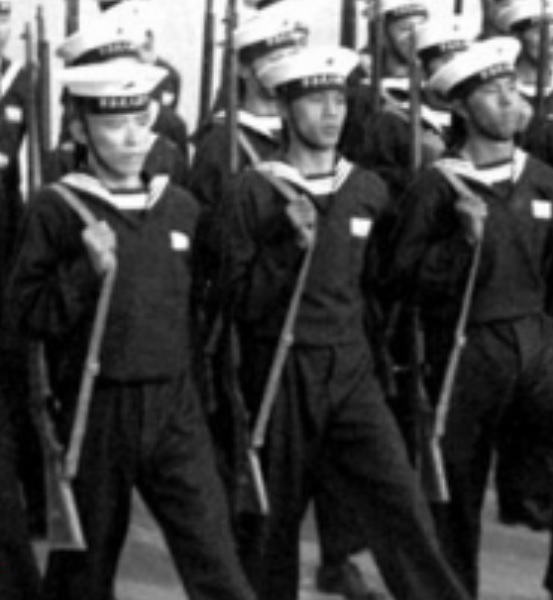
(Communist sailors in 1949 after the Yangtze crossing. A good chunk of the early PLAN (People’s Liberation Army Navy) was ex-nationalist turncoats. The rifles are Cavalry Model Type 38s, a variant the Imperial Japanese Army intended for quartermaster, railway, and horse units. It was shorter than a regular Type 38 and lacked a bayonet boss, but was otherwise identical.)
Despite having a 2.2 : 1 manpower advantage and being dug in, nationalist resistance crumbled and by nightfall on 22 April, multiple beachheads had been secured and reinforcements continued to pour across the Yangtze.
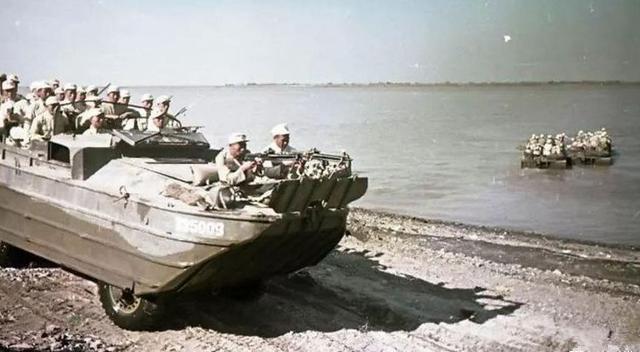
(In what is probably a propaganda reenactment of the event, this 1949 photo shows communist troops crossing the Yangtze in ex-American DUKW amphibious vehicles. The DUKW in front is armed with a pair of ex-Japanese Type 11 light machine guns.)
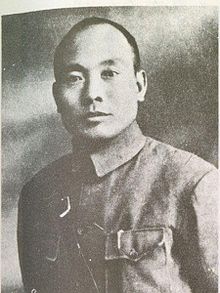
(General Tang Enbo)
Whether or not the KMT realized it (or was willing to accept the reality of it), the Yangtze crossing was the beginning of the end for nationalist control of Shanghai. In desperation, the high command structure was reorganized and Gen. Tang Enbo was made commander of a broad triangle of China, including the nationalist capital Nanking, Shanghai on the coast, and all of the remaining major ports: Hangzhou, Fuzhou, Xiamen, and Canton.
Gen. Tang had, quite surprisingly, received his senior training at the Imperial Japanese Army Academy in Ichigaya during the 1930s; being one of the last Chinese officers in the international fellowship program before the Sino-Japanese War. Tang was one of the few Chinese generals the IJA had respect for, and gave a decent showing of his skills during WWII. Now in 1949, Chiang Kai-shek placed high hopes in him to somehow turn around the situation.
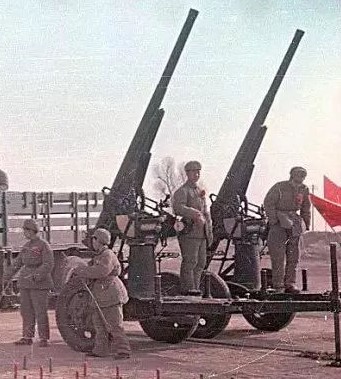
(In the early stages of the Chinese Civil War, the communists were helpless against nationalist air power. But by 1949, when this photo was taken, they had some fighter planes and organized ground anti-aircraft units. These are ex-Japanese Type 88 AA guns, a 75mm weapon.)
Generalissimo Chiang Kai-Shek instructed a “scorched earth order” in that any municipality was to be defended to the last possible moment, and then destroyed. This included major cities like Nanking and Shanghai.
On 24 April 1945, Nanking was captured by the communists. Gen. Tang Enbo’s defensive plan was wholly ineffective. The scorched earth order was ignored. Nanking was the last domino before Shanghai.
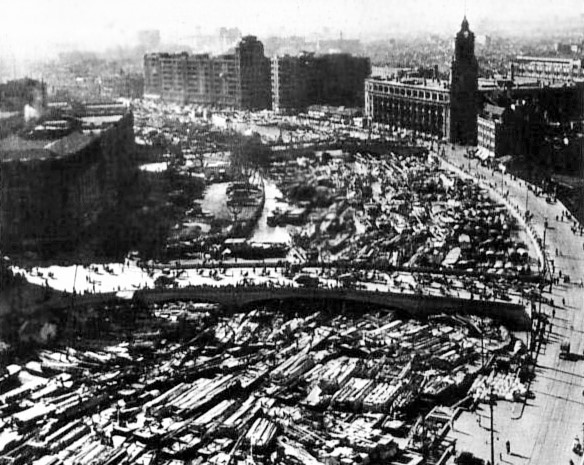
The above photo shows a surreal scene in Shanghai a week or two after the fall of Nanking in 1949. Taken from the Broadway building, Suzhou Creek is completely packed with civilian sampans and junks fleeing the communist advance further inland. The last-minute influx of refugees further complicated nationalist defense of Shanghai.
the nationalist defense and communist attack plans

(A nationalist soldier mans a sandbag emplacement underneath a civilian advertisement in Shanghai during 1949. Some Tommy helmets, Lend-Leased by the UK during WWII, were still in use as seen.)
In May 1949, to defend Shanghai, the nationalists had 211,000 troops. They were opposed by 290,000 communist troops. Although outnumbered, the nationalists had advantages in airpower, tanks, artillery, and by the fact that they were the defenders.
These numbers are not completely telling however. The communists could draw from a further 110,000 reserves garrisoning newly-captured towns inland; meanwhile the nationalists (after the decision to evacuate was made) were not only out of reinforcements, but actually deducting forces.
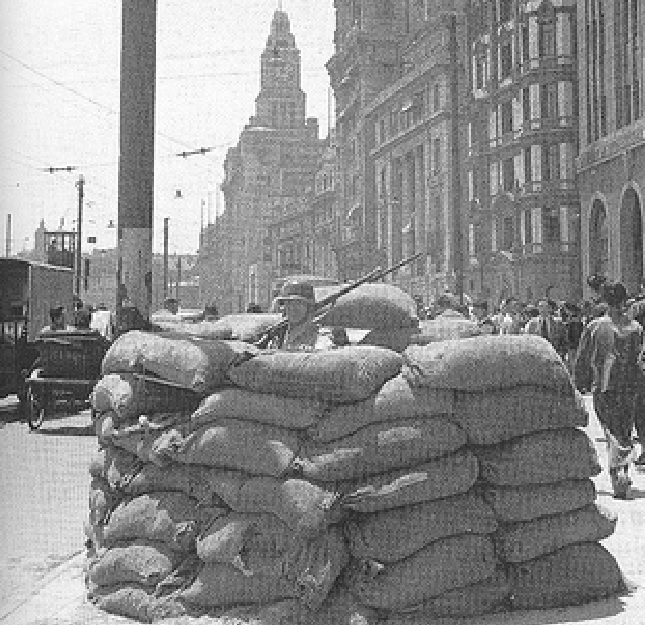
(A nationalist soldier in stahlhelm mans a sandbagged position in the Bund during May 1949, as daily Shanghai life goes on around him.)
The original nationalist plan was to defend the city along natural features: the east and west banks of the Huangpu River and north and south banks of Suzhou Creek, northwards up to the mouth of the Yangtze.
There was a political aspect of the defensive plan as well. Generalissimo Chiang Kai-shek felt that if Shanghai held for 6 months, it would illustrate the KMT’s ability to maintain control over portions of the mainland and foster an internationally-brokered armistice of some sort with Mao. It is unclear how Chiang arrived at this conclusion or the 6-month figure, but in any case, that was the original mindset.
The communist plan of attack was an east & west pincer originating in the south, to be followed by a westward general advance and then northwards to the mouth of the Yangtze.
One issue is that the nationalist command structure was muddled. In early May 1949 there were 26 (mostly understrength) divisions in Shanghai along with LtGen. Chiang Wei-kuo’s tank unit plus air force units, the nationalist navy’s 1st Fleet, and remants of the Beijing and Nanking defensive garrisons. However, these 26 divisions were split up between 8 GHQ staffs of corps-level “armies”; long since defeated in other battles but still formally existing to justify paychecks. While Gen. Tang Enbo was supreme commander, there were also three other generals and several lieutenant generals in the city. Meanwhile, the attacking communist forces were organized in 10 full-strength divisions belonging to just four corps-level commands.
the decision to evacuate
At some point during April 1949, the KMT made the decision to evacuate as many men, guns, and vehicles as possible out of Shanghai to Taiwan; as opposed to further reinforcing the city.
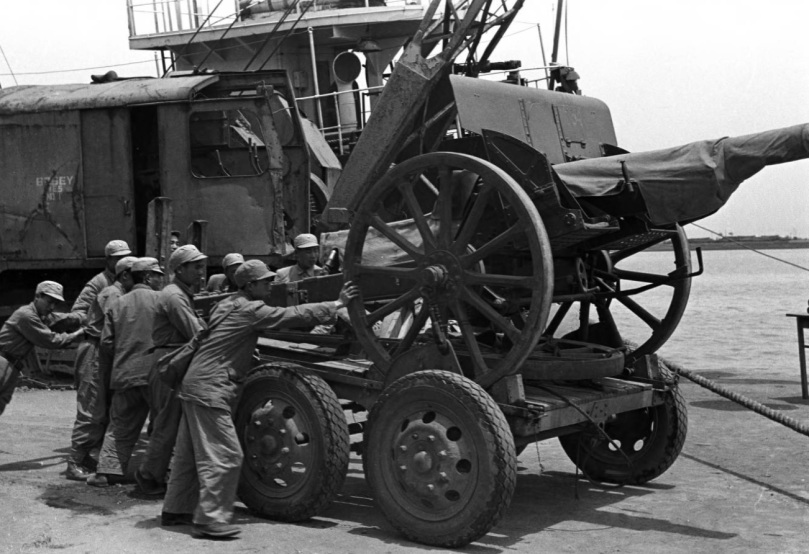
(A nationalist ex-Japanese Type 91 howitzer in Shanghai being loaded onto the merchant ship S.S. Hai Wan for evacuation to Taiwan in 1949. This 105mm weapon of WWII had a 6¼ mile range and was obsolete.) (photo by Harrison Forman)
In numerous ways, the writing on the wall for this decision had already been made several months previous. USS Algol (AKA-54) delivered 5,000 tons of war goods to the nationalists in Shanghai in late November 1948. The “Steamin’ Demon” during WWII, now USS Algol ended up being the final delivery of new arms to the nationalists in Shanghai. Thereafter, the nationalists requested further arms be delivered first to Taiwan for redistribution to Shanghai from there; a de facto way of saying they probably would never make it to the city. After the end of January 1949, all American aid was diverted to Taiwan with no pretenses of ever seeing the mainland.
The evacuation was not carried out particularly well. In February – March 1949, a huge amount of time and shipboard space was wasted evacuating personal cars and household goods of KMT officials. Then in April, and in May as the battle started, the evacuations were carried out on a unit basis. While this may have initially made sense, it resulted in second-tier assets like the ex-Japanese gun above or the old ex-Soviet T-26s being sent to Taiwan while higher-quality items like M5 Stuarts or M1903 Springfields were left behind.
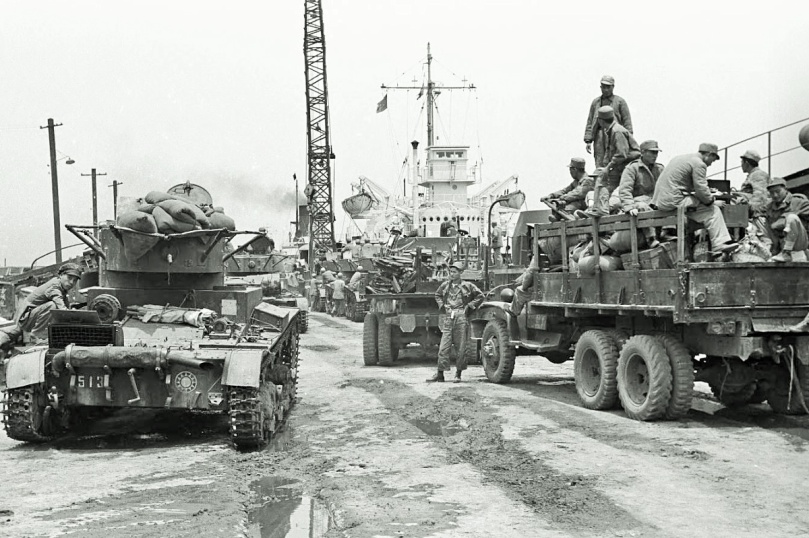
(photo by Harrison Forman)
There was another, more grim, aspect. With any “Dunkirk-style” military evacuation, there needs to be a fighting rear guard covering the operation for as long as possible. For this, ten divisions were earmarked as “last to evacuate”; they being seven MP divisions and three infantry divisions. The MP divisions were of a type which translates from Mandarin to English as “Traffic Police” and do not really equate to what American readers think of military police; rather; they were normally tasked with securing highways and urban areas against enemy action. Meanwhile the infantry divisions were largely fresh conscripts. After the final battle, they were largely characterized as unwitting dupes, often Shanghai residents who bought into cheery KMT news releases and had no idea how precarious the nationalist position really was in 1949.
The 1949 photo above shows a T-26 in Shanghai supposedly earmarked for evacuation, while the infantry in the trucks were not. If this account is accurate, it must have been an awkward moment.
the battle
On 12 May 1949, the final battle for Shanghai began. The communists secured both banks of the minor Liu River on the city’s outskirts, destroying two entire nationalist divisions in the process.
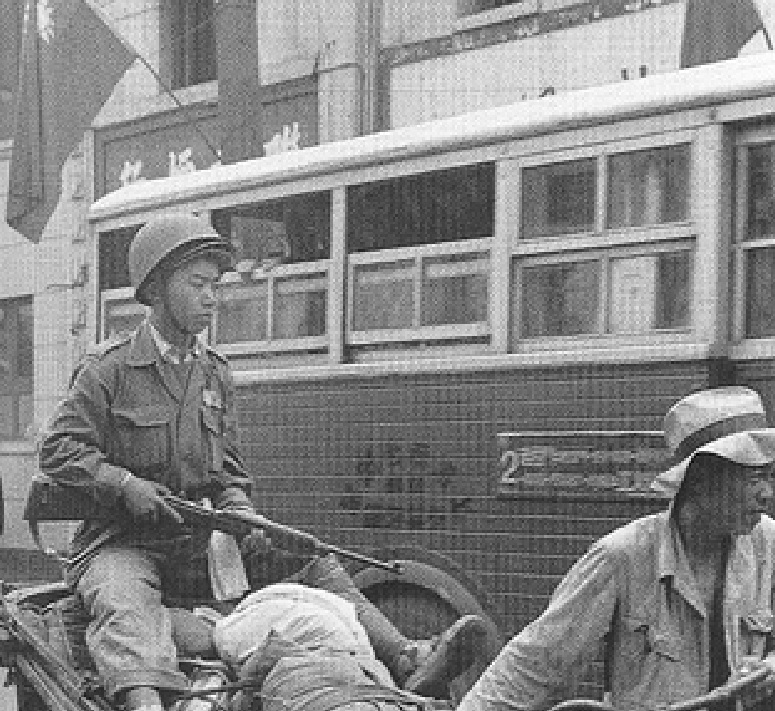
(A nationalist soldier rides a rickshaw through Shanghai in 1949. The USA had Lend-Leased 52,569 M1 carbines to China during WWII with more coming after the war.)
As the battle started, communist leaders issued a ban on using “heavy weapons” in the inner parts of the city; this generally meaning crew-served artillery and tanks. This was less of civic-mindedness, and more of a goal to avoid millions of refugees streaming out of the city and clogging logistics routes.
Gen. Tang Enbo’s leadership
The nationalist CinC, Gen. Tang, will forever be associated with the nationalist defeat in Shanghai.
On 24 April 1949, General Tang issued his “10 New General Orders” outlining prohibited actions by nationalist defenders of Shanghai. Of the ten items, six (attempt to surrender, retreat without authorization, desertion, insubordination, lowering morale, and unsecure communications use) were now punished by immediate execution on the battlefield. The intent was to galvanize discipline but instead the speech further depressed the spirits of nationalist enlistedmen.

(A nationalist DUKW in Shanghai’s Bund during the 1949 battle. During WWII, the American military used the amphibious DUKW, or “Duck”, to great effect in over-beach assaults. During the Chinese Civil War, both sides used them as “river-hoppers” and substitute trucks.)
For General Tang’s legacy the problem comes from a rumor that, as communist forces approached, he indicated that in exchange for several million American dollars wired to a bank account in American-occupied Japan, he would surrender intact all nationalist forces with all their weapons, in addition to Shanghai itself, and then make his way to Tokyo. It is unknown if this really happened. If such an offer was made, it was refused. The communists probably didn’t have that much in hard currency reserves and even if they did, they were going to win on the battlefield anyways, so why pay.
Gen. Tang’s reputation took a further hit in 1949 with the fall of Xiamen, unrelated to the Shanghai battle. Here, a grossly inept defensive strategy can legitimately be blamed on him.
It remains unknown if the stories of Tang’s fickle loyalties are true. Generalissimo Chiang Kai-shek himself somewhat alluded to believing them, at least partially. Gen. Tang did indeed later purchase a mansion in Tokyo, where he passed away in 1954.
the fall of Shanghai
On 13 May 1949, communist troops overran the suburb of Taicang, with the nationalists losing 2,000 men KIA plus another 1,000 taken POW in less than 10 hours.
On 15 May 1949, the USA’s “special Shanghai office” of the Foreign Liquidation Commission in Manila (the agency which doled out WWII weapons to postwar Asian allies) shut down, indicating the United States viewed Shanghai as a lost cause.
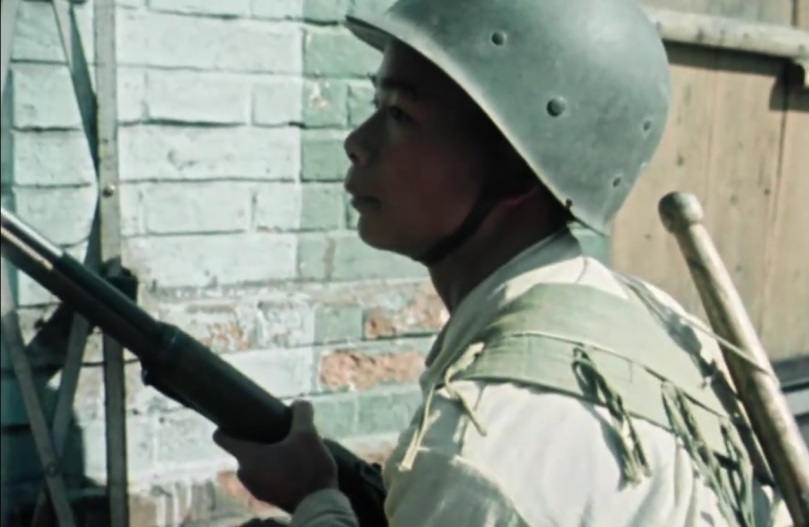
(A communist soldier on the attack inside Shanghai. Rifle is a Japanese Type 38, and the headwear is the inner part of an American M1 pot with the outer steel shell missing. The bandolier and entrenchment tool are captured nationalist Chinese items.)
As the communist pincers closed in, the nationalists attempted to accelerate the pace of evacuations, all the while still conducting a battle.
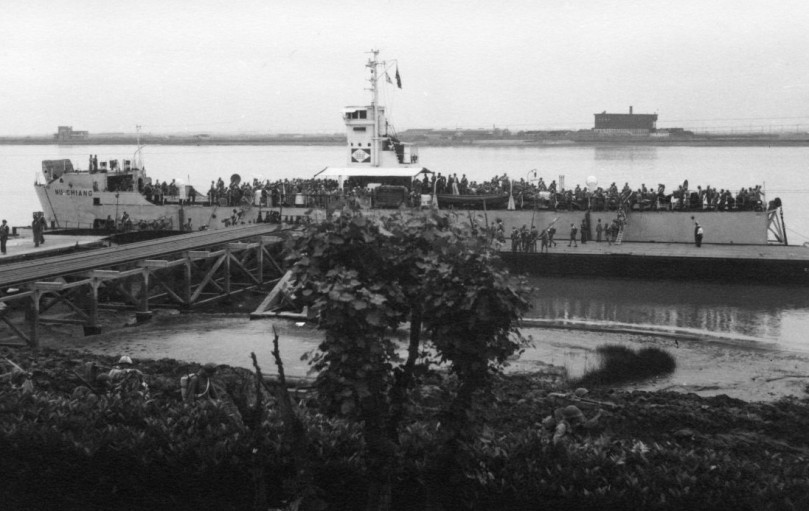
(photo by Carolyn Davidson-Hill)
As the highways surrounding Shanghai became endangered or cut, the nationalists used the city’s rivers to redeploy troops protecting the evacuation. The above photo shows defenders disembarking at the CalTex oil company pier. The “merchant” Hu Chiang is obviously a barely-modified American WWII amphibious assault ship, probably LSM-55 which had been “decommissioned, disarmed, and delivered to local relief agency in Shanghai” on 26 May 1946.
On 23 May 1949, communist troops entered Shanghai’s city center down Caobao Road, fanning out. Most nationalist generals still in the city, including Tang Enbo, were immediately evacuated to Taiwan. On 25 May, nationalist forces in the Bund and city center made a mass retreat northwards to the Yangtze river’s mouth, where evacuations were still ongoing. A detachment of military police, with estimates ranging between 200 to 1,000, barricaded themselves inside the Broadway building and took pot shots out of windows at communist troops in the Bund and along Suzhou Creek. Communist officers ordered that the landmark not be attacked and eventually the defenders gave up.

(Communist troops in the Bund. The disassembled machine guns are Type 24s, while the soldier on point has a Chiang Kai-shek Rifle.)
At 18:00 on 26 May 1949, an American diplomat in Shanghai sent a telegram to the State Department in Washington DC. He reported that communist infantry were on both the east and west sides of the Huangpu River and both the north and south sides of Suzhou Creek, and that at least in the city center, the battle was over, although sounds of combat could still be heard in the distance north of the city. This was no doubt, the last nationalist evacuations taking place from the Yangtze’s riverbank under fire.

(A communist cavalry unit crosses Garden Bridge. Some windows in the Broadway building behind it had been broken out by nationalist snipers as described above. The PLA used horse cavalry at the division level until 1969 and at smaller subunit levels into the late 1970s.)
At 15:00 on 27 May 1949, one of the last potential problems for the communists was averted. A detachment of nationalist infantry, most of them teenage draftees, had holed up inside Shanghai’s power plant with orders to defend it as long as possible, then dynamite the generators and set the city’s coal pile on fire. This would have been an economic disaster for Shanghai. A turncoat nationalist NCO negotiated on behalf of the communists and persuaded the young soldiers to surrender peacefully. With that, it was reported to Mao that Shanghai had fallen intact.
To the north of Shanghai, a large flat island called Chongming rests in the middle of the Yangtze’s mouth. The KMT leadership in Taiwan had stationed a whole infantry division on the island to hold it even if Shanghai fell, as a symbolic piece of the city. This hopeless and foolish objective resulted in the division’s near-destruction, first from communist artillery on the Yangtze’s southern riverbank and then from infantry landing on the island via commandeered civilian junks. Belatedly, the KMT leadership came to its senses and ordered an evacuation on 1 – 2 June 1949. But most of the division’s men and all of its gear was wasted.
the immediate aftermath
Of the 211,000 nationalist defenders in Shanghai when the battle began, 57,000 were successfully evacuated. The rest (153,000 or 73%) were KIA, taken POW, or deserted. The attacking communist forces suffered 9,951 KIA and 24,122 wounded (12%). Generalissimo Chaing Kai-shek’s “scorched earth” order was ignored and Shanghai was barely damaged by the fighting.
The real story was the massive amount of war gear captured intact. The communists captured 119 tanks, 1,370 crew-served weapons (heavy machine guns or artillery), 1,161 military vehicles of other types, 11 warships, an airbase with depot of high-octane aviation fuel, and tons of ammunition in various calibers. The number of rifles and submachine guns is unknown but had to have been in the tens of thousands.
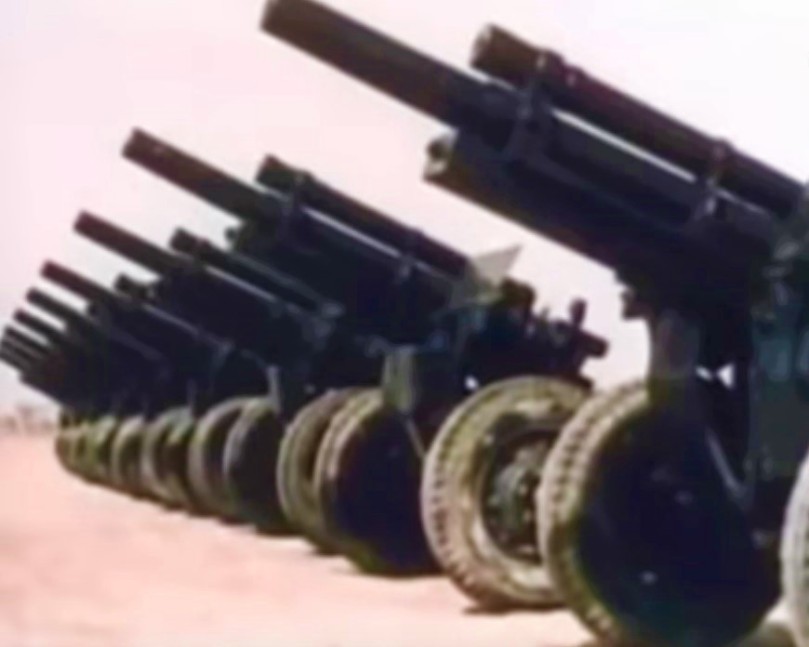
(Nine M2A1 howitzers captured in Shanghai in 1949. This excellent 105mm American WWII howitzer had a 7 mile range. China used M2A1s captured during the Chinese Civil War against American troops during the Korean War.)

(This PLA M5A1 Stuart, today in a museum, is said to have been captured during the 1949 Shanghai battle.)

(A WWII American LCIL amphibious landing craft, flying the communist Chinese flag after the 1949 Shanghai battle. This had probably been one of the Public Law 512 transfers to the nationalists.)
The defeat in Shanghai set off a chain reaction for the nationalists on China’s eastern seaboard. Qingdao fell on 2 June 1949 and the rest of the seaports in Shandong and Jinagsu provinces shortly thereafter. Around Shanghai, isolated pockets of nationalist troops who missed the evacuation mounted a petty guerilla war into early 1950.
After their victory, the communist People’s Liberation Army conducted two reinforcement & repositioning phases in Shanghai. The first was in June 1949, and sought to get divisions involved in the battle back into formation. With the battle complete, the communists brought tanks into the city. Citizens had told them a rumor of an impending US Marine Corps attack to win back Shanghai for the nationalists. This was completely false but the rumor was popular enough apparently that the PLA commanders were not going to take any chances.

(Communist troops ride an ex-Japanese Type 92 Jyu-Shokosha in the Bund. Armed with a wimpy 13mm main gun, this light tank was already obsolete during WWII and more so by 1949. The wheeled vehicles behind the tank are General Motors trucks overlaid with sheet metal shells as makeshift APCs.)

(Communist troops with Arisaka Type 38 rifles during the first redeployment phase in Shanghai.)
The second phase, which came in the late summer and early autumn of 1949, basically established the peacetime garrison strength for defending the city. China also made use of this phase to “document” the earlier battle on film, and many newsreels (including the nationalist sun flag being thrown off the top of the Broadway building) were actually filmed by actors during this time, when there was a lot of military movement happening in the city for cameras to capture.

(A Type 97 Chi-Ha of the PLA in Shanghai during 1949.)

(A communist AA emplacement on the roof of the Broadway building in late 1949. The machine gun is a Nambu Type 92. Its hard to imagine a firearm less suitable for the AA task than this WWII Japanese gun fed by 30-round tapes.)
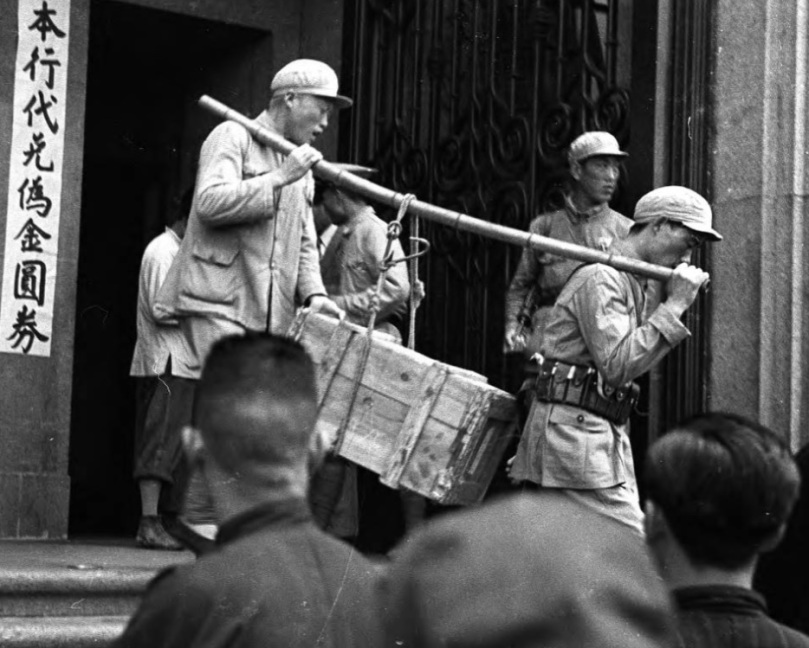
The above photo is astonishing. During the 1949 battle the KMT leadership in Taiwan raided all of the banks in Shanghai – from giants like Chase Manhattan and HSBC, down to little neighborhood “dollarbanks” – and took all their gold bullion, foreign currency, and bearer bonds to Taiwan. After the battle this left them with reserves insufficient to meet depositor accounts. Despite the antipathy between maoist doctrine and capitalist banking, the PLA acted to prevent a bank run which would have collapsed Shanghai’s civic order. Here a crate of money is being transported to bail out a capitalist bank; quite a remarkable task for communist soldiers.
the 1950 air raids
There was one final act to play out. On 25 January 1950, eight months after the city fell, the ROCAF in Taiwan made a large bombing raid against Shanghai with 17 four-engine B-24 Liberators. The second wave on 6 February 1950 was a hodge-podge of twin-engine WWII warplanes, mostly B-25 Mitchells but the most interesting being three WWII Japanese bombers.

(The two “Lily” bombers in the 1950 raid were by then add-ons to a P-47 Thunderbolt fighter squadron.)
Two of the planes were Kawasaki Ki-48 “Lily” medium bombers formerly of the Imperial Japanese Army. The four-man Ki-48 had a top speed of 273 kts and carried up to 1,764 lbs of bombs.

The third plane was a Yokosuka P1Y “Frances”, a land-based strike plane of the Imperial Japanese Navy with a top speed of 295 kts.
This air raid originated from the Zhoushans, a small group of tiny islands offshore of the city of Ningbo on China’s east coast. Even after the falls of Shanghai and Ningbo in 1949, the nationalists maintained control of these small offshore islands. The distance to Shanghai is only 100 miles, so the city was easily in range.
The two air raids combined damaged Shanghai’s electrical grid and killed 500 people, almost all of them civilians. Thereafter the USSR detached a fighter squadron to the ex-Japanese, ex-American airbase near Shanghai to preclude further raids. China captured the Zhoushans during the summer of 1950, pushing Shanghai out of range of twin-engine WWII bombers anyways. The results of the three ex-Japanese planes in the 1950 raid, and their final fates, are unknown.
POSTSCRIPT
Now in the 21st century, it is hard to recapture the worldwide shock of the 1949 fall of the city. Shanghai was, at the time, Earth’s fifth-largest city. It was famous worldwide, either through commerce or Hollywood portrayals. In a modern context, it would be like picking up a newspaper tomorrow to read that a guerilla army had overrun Sydney or Chicago.

(A poster of Mao on the entrance to the former British consulate in Shanghai. It was later made into a shipping center.)
The battle was the last time some of the bizarre weapons combinations seen would be together. Communist China made limited use of WWII Japanese gear during the Korean War, but such a wide assortment of German, Canadian, American, Japanese, British, Soviet, and Chinese kit would not fight together again.

(Taken in 1973, this photo shows a ’47 DeSoto Deluxe still running in Shanghai at that time; doubtlessly one left behind by the fleeing nationalists in 1949.)
The 1949 battle also marked the permanent end of “old” Shanghai; with the former concession areas, the international treaty rights, and the city’s wild character all fading away.
Some of General Tang Enbo’s concrete pillboxes from 1949 remain around the city but by and large, little remains of WWII, the brief US Navy presence, or the Chinese Civil War.

(Shanghai in 2017, looking west at the confluence of the Huangpu River and Suzhou Creek. The gold-lit buildings of the Bund are dwarfed by the modern city. The Huangpu’s east side, where the new skyscrapers and Pearl Tower are today, was an underdeveloped industrial zone in 1949.) (photo via Ohio State University)

Outstanding post. Thanks for the history lesson.
LikeLiked by 1 person
As per usual, a fantastic gem of knowledge.
LikeLiked by 1 person
This was another outstanding, detailed look at a part of WW2 largely forgotten in the West. Thanks for all the effort that clearly went into this.
LikeLiked by 1 person
Johnson rifles!?!? Lucky bastards.
LikeLiked by 1 person
Very nice. What always impresses me is the number of photographs. Photos that I deem difficult to find by a casual search. Outstanding amount of details and information.
LikeLiked by 1 person
Thanks for the article. Could you please tell exact name of 1943 US Army document mentioned?
LikeLike
Division Of Defense Aid Report. I believe the US Army’s book “Stillwell’s Mission To China” also touches on it,
LikeLike
Outstanding. A tour de force of information! One tiny comment, the Japanese Arisaka Type 38 Carbine mounts the standard Type 30 Japanese bayonet.
My company’s office in Shanghai is right opposite to the Russian consulate pictured above, there’s also a nice Hyatt there. There is also a PLA Navy base there where I once saw a submarine moored (~2011).
LikeLiked by 1 person
Coincidentally, after reading this post yesterday, I found an alleged use of the Hanyang Type 24 MG today in China. This is supposedly a local militia in China enforcing their quarantine. It’s undoubtedly modern, note the electric scooter in the photo.
LikeLiked by 1 person
holy cow that is incredible!
LikeLike
Great article,!I’m Chinese, and many of these photos are the first time I’ve seen them. There is still a small amount of LST on the Yangtze River as a car ferry. I used to saw it when I was a kid. The Naval Museum in Qingdao once kept a LST in good condition, called “Dabie Mountain”, but it is no longer found.
LikeLike
Thank you!
LikeLike
Excellent article. I love the part on the Chiang Kai-shek/Type Zhongzheng Mauser rifle and it’s use by both the Nationalists and the Communists during the Chinese Civil War. This rifle (along with the Mauser 98 series) is still well-revered in present-day China and Taiwan (Republic of China) as it symbolised China of the first half of the 20th century. I also know that the USSR provided captured WWII German Mauser Kar98k rifles to the Chinese during the Korean War
It’s also ironic that the Chinese Communist war memorial with the large Hanyang 88 rifle sculpture is located in the same city where the current Coronavirus pandemic started.
In closing, here’s a YouTube video of the People’s Republic of China of the early 1950s, filmed by Soviet film makers and photographers during the short-lived period of Sino-Soviet co-operation.
LikeLiked by 1 person
Hello, fantastic content and images. Just a few errors I think can be corrected? The picture of the Type 92 tankette and the line of armoured cars behind it, the armoured cars are not APCs. I have no other information other than it was converted from trucks by the KMT. Regarding the Type 24 Heavy Machine Gun, according to a book written by Bin Shih on Chinese firearms of the Second Sino-Japanese war, he stated the Type 24 was designed by engineers from the Jinling Arsenal (somewhere around Nanking), and was not a copy of the MG 08 or MG 09. Also the Taiyuan Arsenal actually made successful copies of the Thompson SMG and was used by the local provincial troops as well the communists who captured some along the way in the 1930s during the Long March. There are some images of them online, hope you can find them. Otherwise, amazing images that you found, really fantastic. 🙂
LikeLiked by 1 person
Hello Xuan thank you for the info. The only things I could find on the “APCs” were that the KMT made them by removing most of the body paneling of a 1940s General Motors truck (I dont know which exact year) and they re-topping the whole engine and chassis and cab with a one piece shell of welded steel.
LikeLike
The Bren guns were built by Inglis, not Ingals.
LikeLike
Scottish pronunciation.
LikeLike